David Simon's Blog, page 13
May 19, 2017
Qumran
We will visit Qumran, an ancient site along the Dead Sea during a 14 day trip to the Holy Land in May 2018. This is the village of the Essenes and the place where a shepherd boy found the first of the Dead Sea Scrolls. The settlement has a long and interesting history and has influenced our faith in many ways. Qumran sits near the Dead Sea. It is an isolated location, far from Jerusalem and the populated areas of Israel. The men who moved to Qumran did so to get away from multitudes of people, what they felt was a corrupted priesthood and to avoid foreigners who were influencing the Israelites in wrong ways. Philo wrote “They flee the cities and live in villages where clean air and clean social life abound. They either work in the fields or in crafts that contribute to peace.”
Qumran sits near the Dead Sea. It is an isolated location, far from Jerusalem and the populated areas of Israel. The men who moved to Qumran did so to get away from multitudes of people, what they felt was a corrupted priesthood and to avoid foreigners who were influencing the Israelites in wrong ways. Philo wrote “They flee the cities and live in villages where clean air and clean social life abound. They either work in the fields or in crafts that contribute to peace.”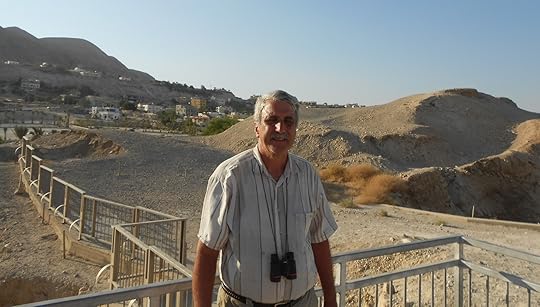 The people who lived in Qumran were a monastic sect called the Essenes. Philo described them in this way, “They do not hoard silver and gold and do not acquire great landholdings; procuring for themselves only what is necessary for life. Thus they live without goods and without property, not by misfortune, but out of preference. They do not make armaments of any kind. They do not keep slaves and detest slavery. … With respect to philosophy, they dismiss logic but have an extremely high regard for virtue. They honor the Sabbath with great respect over the other days of the week. They have an internal rule which all learn, together with rules on piety, holiness, justice and the knowledge of good and bad.”
The people who lived in Qumran were a monastic sect called the Essenes. Philo described them in this way, “They do not hoard silver and gold and do not acquire great landholdings; procuring for themselves only what is necessary for life. Thus they live without goods and without property, not by misfortune, but out of preference. They do not make armaments of any kind. They do not keep slaves and detest slavery. … With respect to philosophy, they dismiss logic but have an extremely high regard for virtue. They honor the Sabbath with great respect over the other days of the week. They have an internal rule which all learn, together with rules on piety, holiness, justice and the knowledge of good and bad.”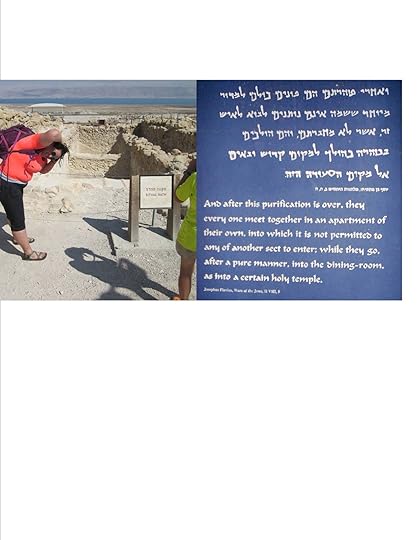 Pliney the Elder wrote, “To the west (of the Dead Sea) the Essenes have put the necessary distance between themselves and the insalubrious shore. They are a people unique of its kind and admirable beyond all others in the whole world; without women and renouncing love entirely, without money and having for company only palm trees. Owing to the throng of newcomers, this people is daily reborn in equal number; indeed, those whom, wearied by the fluctuations of fortune, life leads to adopt their customs, stream in in great numbers. Thus, unbelievable though this may seem, for thousands of centuries a people has existed which is eternal yet into which no one is born: so fruitful for them is the repentance which others feel for their past lives!"
Pliney the Elder wrote, “To the west (of the Dead Sea) the Essenes have put the necessary distance between themselves and the insalubrious shore. They are a people unique of its kind and admirable beyond all others in the whole world; without women and renouncing love entirely, without money and having for company only palm trees. Owing to the throng of newcomers, this people is daily reborn in equal number; indeed, those whom, wearied by the fluctuations of fortune, life leads to adopt their customs, stream in in great numbers. Thus, unbelievable though this may seem, for thousands of centuries a people has existed which is eternal yet into which no one is born: so fruitful for them is the repentance which others feel for their past lives!" Josephus says, “They renounce pleasure as an evil, and regard continence and resistance to passions as a virtue. They disdain marriage for themselves, being content to adopt the children of others at a tender age in order to instruct them. They do not abolish marriage, but are convinced women are all licentious and incapable of fidelity to one man. They despise riches. When they enter the sect, they must surrender all of their money and possessions into the common fund, to be put at the disposal of everyone; one single property for the whole group. Therefore neither the humiliation of poverty nor the pride of possession is to be seen anywhere among them.”
Josephus says, “They renounce pleasure as an evil, and regard continence and resistance to passions as a virtue. They disdain marriage for themselves, being content to adopt the children of others at a tender age in order to instruct them. They do not abolish marriage, but are convinced women are all licentious and incapable of fidelity to one man. They despise riches. When they enter the sect, they must surrender all of their money and possessions into the common fund, to be put at the disposal of everyone; one single property for the whole group. Therefore neither the humiliation of poverty nor the pride of possession is to be seen anywhere among them.” Josephus also wrote, “Before sunrise they recite certain ancestral prayers to the sun as though entreating it to rise. They work until about 11 A.M. when they put on ritual loincloths and bathe for purification. Then they enter a communal hall,where no one else is allowed,and eat only one bowlful of food for each man, together with their loaves of bread. They eat in silence. Afterwards they lay aside their sacred garment and go back to work until the evening. At evening they partake dinner in the same manner. During meals they are sober and quiet and their silence seems a great mystery to people outside. Their food and drink are so measured out that they are satisfied but no more.”
Josephus also wrote, “Before sunrise they recite certain ancestral prayers to the sun as though entreating it to rise. They work until about 11 A.M. when they put on ritual loincloths and bathe for purification. Then they enter a communal hall,where no one else is allowed,and eat only one bowlful of food for each man, together with their loaves of bread. They eat in silence. Afterwards they lay aside their sacred garment and go back to work until the evening. At evening they partake dinner in the same manner. During meals they are sober and quiet and their silence seems a great mystery to people outside. Their food and drink are so measured out that they are satisfied but no more.” The men of Qumran are famous for their scrolls. The community copied scriptures, works written by others and writings of their own. The copyists worked in a disciplined manner so the product of their work would be error free. They counted letters to make sure each scroll was correctly copied, and then the scrolls were checked for style. Letters could not touch each other and the script had to conform to a specific style.
The men of Qumran are famous for their scrolls. The community copied scriptures, works written by others and writings of their own. The copyists worked in a disciplined manner so the product of their work would be error free. They counted letters to make sure each scroll was correctly copied, and then the scrolls were checked for style. Letters could not touch each other and the script had to conform to a specific style. The Essenes assembled a library of scrolls. Every book of the Bible, with the exception of Esther, is contained in their library. Other great works both religious and nonreligious can be found also. Writings of their teachers are found among the scrolls and give clues to their theology.
The Essenes assembled a library of scrolls. Every book of the Bible, with the exception of Esther, is contained in their library. Other great works both religious and nonreligious can be found also. Writings of their teachers are found among the scrolls and give clues to their theology. During our 14 day trip to the Holy Land in May 2018 we will see the ruins of Qumran. We will see the Scriptorium, mikvah pools, craft houses and kitchen. We will also have the opportunity to walk up to caves where the scrolls were stored. We can climb into several caves to explore and see how they connect together.
During our 14 day trip to the Holy Land in May 2018 we will see the ruins of Qumran. We will see the Scriptorium, mikvah pools, craft houses and kitchen. We will also have the opportunity to walk up to caves where the scrolls were stored. We can climb into several caves to explore and see how they connect together.
The site was destroyed during the first Jewish-Roman War of 66-70 AD. With the dissolving of Jewish society the Essene communities ceased to exist.
 Qumran sits near the Dead Sea. It is an isolated location, far from Jerusalem and the populated areas of Israel. The men who moved to Qumran did so to get away from multitudes of people, what they felt was a corrupted priesthood and to avoid foreigners who were influencing the Israelites in wrong ways. Philo wrote “They flee the cities and live in villages where clean air and clean social life abound. They either work in the fields or in crafts that contribute to peace.”
Qumran sits near the Dead Sea. It is an isolated location, far from Jerusalem and the populated areas of Israel. The men who moved to Qumran did so to get away from multitudes of people, what they felt was a corrupted priesthood and to avoid foreigners who were influencing the Israelites in wrong ways. Philo wrote “They flee the cities and live in villages where clean air and clean social life abound. They either work in the fields or in crafts that contribute to peace.” The people who lived in Qumran were a monastic sect called the Essenes. Philo described them in this way, “They do not hoard silver and gold and do not acquire great landholdings; procuring for themselves only what is necessary for life. Thus they live without goods and without property, not by misfortune, but out of preference. They do not make armaments of any kind. They do not keep slaves and detest slavery. … With respect to philosophy, they dismiss logic but have an extremely high regard for virtue. They honor the Sabbath with great respect over the other days of the week. They have an internal rule which all learn, together with rules on piety, holiness, justice and the knowledge of good and bad.”
The people who lived in Qumran were a monastic sect called the Essenes. Philo described them in this way, “They do not hoard silver and gold and do not acquire great landholdings; procuring for themselves only what is necessary for life. Thus they live without goods and without property, not by misfortune, but out of preference. They do not make armaments of any kind. They do not keep slaves and detest slavery. … With respect to philosophy, they dismiss logic but have an extremely high regard for virtue. They honor the Sabbath with great respect over the other days of the week. They have an internal rule which all learn, together with rules on piety, holiness, justice and the knowledge of good and bad.” Pliney the Elder wrote, “To the west (of the Dead Sea) the Essenes have put the necessary distance between themselves and the insalubrious shore. They are a people unique of its kind and admirable beyond all others in the whole world; without women and renouncing love entirely, without money and having for company only palm trees. Owing to the throng of newcomers, this people is daily reborn in equal number; indeed, those whom, wearied by the fluctuations of fortune, life leads to adopt their customs, stream in in great numbers. Thus, unbelievable though this may seem, for thousands of centuries a people has existed which is eternal yet into which no one is born: so fruitful for them is the repentance which others feel for their past lives!"
Pliney the Elder wrote, “To the west (of the Dead Sea) the Essenes have put the necessary distance between themselves and the insalubrious shore. They are a people unique of its kind and admirable beyond all others in the whole world; without women and renouncing love entirely, without money and having for company only palm trees. Owing to the throng of newcomers, this people is daily reborn in equal number; indeed, those whom, wearied by the fluctuations of fortune, life leads to adopt their customs, stream in in great numbers. Thus, unbelievable though this may seem, for thousands of centuries a people has existed which is eternal yet into which no one is born: so fruitful for them is the repentance which others feel for their past lives!" Josephus says, “They renounce pleasure as an evil, and regard continence and resistance to passions as a virtue. They disdain marriage for themselves, being content to adopt the children of others at a tender age in order to instruct them. They do not abolish marriage, but are convinced women are all licentious and incapable of fidelity to one man. They despise riches. When they enter the sect, they must surrender all of their money and possessions into the common fund, to be put at the disposal of everyone; one single property for the whole group. Therefore neither the humiliation of poverty nor the pride of possession is to be seen anywhere among them.”
Josephus says, “They renounce pleasure as an evil, and regard continence and resistance to passions as a virtue. They disdain marriage for themselves, being content to adopt the children of others at a tender age in order to instruct them. They do not abolish marriage, but are convinced women are all licentious and incapable of fidelity to one man. They despise riches. When they enter the sect, they must surrender all of their money and possessions into the common fund, to be put at the disposal of everyone; one single property for the whole group. Therefore neither the humiliation of poverty nor the pride of possession is to be seen anywhere among them.” Josephus also wrote, “Before sunrise they recite certain ancestral prayers to the sun as though entreating it to rise. They work until about 11 A.M. when they put on ritual loincloths and bathe for purification. Then they enter a communal hall,where no one else is allowed,and eat only one bowlful of food for each man, together with their loaves of bread. They eat in silence. Afterwards they lay aside their sacred garment and go back to work until the evening. At evening they partake dinner in the same manner. During meals they are sober and quiet and their silence seems a great mystery to people outside. Their food and drink are so measured out that they are satisfied but no more.”
Josephus also wrote, “Before sunrise they recite certain ancestral prayers to the sun as though entreating it to rise. They work until about 11 A.M. when they put on ritual loincloths and bathe for purification. Then they enter a communal hall,where no one else is allowed,and eat only one bowlful of food for each man, together with their loaves of bread. They eat in silence. Afterwards they lay aside their sacred garment and go back to work until the evening. At evening they partake dinner in the same manner. During meals they are sober and quiet and their silence seems a great mystery to people outside. Their food and drink are so measured out that they are satisfied but no more.” The men of Qumran are famous for their scrolls. The community copied scriptures, works written by others and writings of their own. The copyists worked in a disciplined manner so the product of their work would be error free. They counted letters to make sure each scroll was correctly copied, and then the scrolls were checked for style. Letters could not touch each other and the script had to conform to a specific style.
The men of Qumran are famous for their scrolls. The community copied scriptures, works written by others and writings of their own. The copyists worked in a disciplined manner so the product of their work would be error free. They counted letters to make sure each scroll was correctly copied, and then the scrolls were checked for style. Letters could not touch each other and the script had to conform to a specific style. The Essenes assembled a library of scrolls. Every book of the Bible, with the exception of Esther, is contained in their library. Other great works both religious and nonreligious can be found also. Writings of their teachers are found among the scrolls and give clues to their theology.
The Essenes assembled a library of scrolls. Every book of the Bible, with the exception of Esther, is contained in their library. Other great works both religious and nonreligious can be found also. Writings of their teachers are found among the scrolls and give clues to their theology. During our 14 day trip to the Holy Land in May 2018 we will see the ruins of Qumran. We will see the Scriptorium, mikvah pools, craft houses and kitchen. We will also have the opportunity to walk up to caves where the scrolls were stored. We can climb into several caves to explore and see how they connect together.
During our 14 day trip to the Holy Land in May 2018 we will see the ruins of Qumran. We will see the Scriptorium, mikvah pools, craft houses and kitchen. We will also have the opportunity to walk up to caves where the scrolls were stored. We can climb into several caves to explore and see how they connect together.
The site was destroyed during the first Jewish-Roman War of 66-70 AD. With the dissolving of Jewish society the Essene communities ceased to exist.
Published on May 19, 2017 03:30
May 11, 2017
En Gedi
What is more fun than floating in the Dead Sea? A walk up the creek at En Gedi in order to take a dip in the pool at the waterfall. We will take this great walk during a 14 day trip to the Holy Land in May 2018.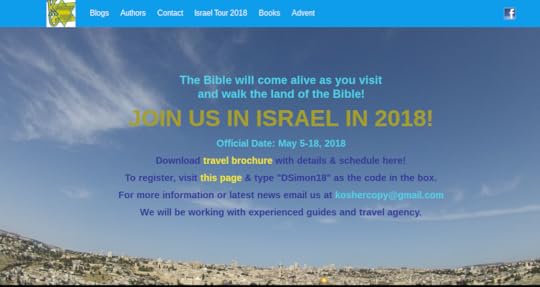 The oasis at En Gedi is very ancient. Settlements have been documented along the freshwater streams since the Chalcolithic era or Copper age in Israel. Remains can be found for rich farming communities, Essene schools, Temples, Synagogues, and Roman Villas. It is written that King David used this region as a hide-out, living in caves and partaking of the rich foods found along the cool streams in the area. En Gedi was famous for its Balsam, Date Palms, Henna, and aromatic resins. Solomon wrote, “My beloved is to me a cluster of henna blossoms in the vineyards of Engedi.”
The oasis at En Gedi is very ancient. Settlements have been documented along the freshwater streams since the Chalcolithic era or Copper age in Israel. Remains can be found for rich farming communities, Essene schools, Temples, Synagogues, and Roman Villas. It is written that King David used this region as a hide-out, living in caves and partaking of the rich foods found along the cool streams in the area. En Gedi was famous for its Balsam, Date Palms, Henna, and aromatic resins. Solomon wrote, “My beloved is to me a cluster of henna blossoms in the vineyards of Engedi.” 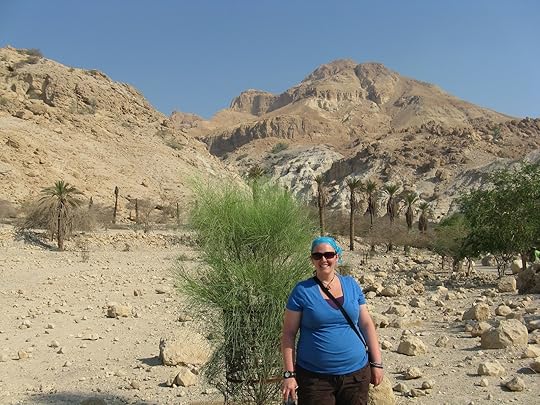 “David went up from there and lived in the strongholds of En Gedi. After Saul returned from pursuing the Philistines, he was told, ‘David is in the Desert of En Gedi.’ So Saul took three thousand able young men from all Israel and set out to look for David and his men near the Crags of the Wild Goats.” (1 Sam. 24) We will walk up Wadi David during our visit at En Gedi.
“David went up from there and lived in the strongholds of En Gedi. After Saul returned from pursuing the Philistines, he was told, ‘David is in the Desert of En Gedi.’ So Saul took three thousand able young men from all Israel and set out to look for David and his men near the Crags of the Wild Goats.” (1 Sam. 24) We will walk up Wadi David during our visit at En Gedi. We will begin our walk in a picnic area shaded by acacia trees and Christ-thorn jujube. Because of the water there is an abundance of plants and animals along the wadi. We will observe small antelope and Rock Hyrax or Conies under and in the trees.
We will begin our walk in a picnic area shaded by acacia trees and Christ-thorn jujube. Because of the water there is an abundance of plants and animals along the wadi. We will observe small antelope and Rock Hyrax or Conies under and in the trees.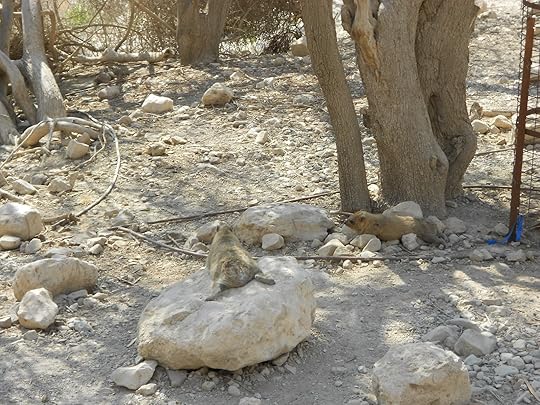 After taking time to look at and take photos of the animals we will walk a well laid out trail along the stream. The trail crosses the stream on bridges giving us a closer look at the valley, the plants and the water flowing through shallow pools and trickling over rocks. We will see the caves in which David camped and trails leading to the Judean heights.
After taking time to look at and take photos of the animals we will walk a well laid out trail along the stream. The trail crosses the stream on bridges giving us a closer look at the valley, the plants and the water flowing through shallow pools and trickling over rocks. We will see the caves in which David camped and trails leading to the Judean heights.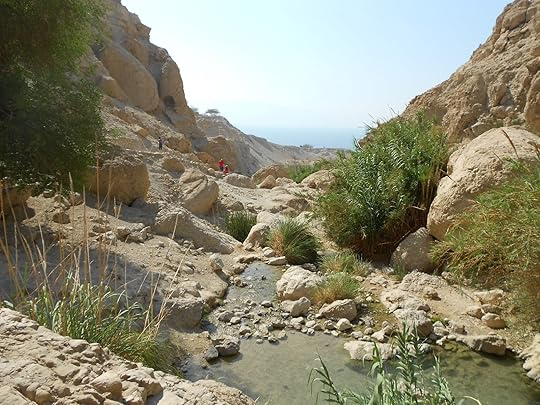 There are many trails which traverse this Ein Gedi National Park which are well laid out and cover the various wadis in the area. The hike for our group will not be difficult, and there are benches along the way. Climbers who have time and are able can ascend along the Zetuya, Ha issiyyim, B ‘nei Hamoshavim, EnGedi or Yishay ascents to Mt. Zenuya on the desert plateau.
There are many trails which traverse this Ein Gedi National Park which are well laid out and cover the various wadis in the area. The hike for our group will not be difficult, and there are benches along the way. Climbers who have time and are able can ascend along the Zetuya, Ha issiyyim, B ‘nei Hamoshavim, EnGedi or Yishay ascents to Mt. Zenuya on the desert plateau. We will ascend at a much more moderate path along the creek, taking time as we desire to look back along the trail we have traveled. The views are different as we look up the hill toward the waterfall and look downwards toward the Dead Sea in the distance. Those who desire can wander a little and rock climb on marked trails. The rest of us will easily navigate a gradual ascent.
We will ascend at a much more moderate path along the creek, taking time as we desire to look back along the trail we have traveled. The views are different as we look up the hill toward the waterfall and look downwards toward the Dead Sea in the distance. Those who desire can wander a little and rock climb on marked trails. The rest of us will easily navigate a gradual ascent. Our climb will end at David’s waterfall below Dodim’s Cave. We will have time to put or feet in the water, or if prepared we will be able to get into the water and refresh ourselves. From the pool we will be able to stand under the waterfall and look down the canyon to the Dead Sea.
Our climb will end at David’s waterfall below Dodim’s Cave. We will have time to put or feet in the water, or if prepared we will be able to get into the water and refresh ourselves. From the pool we will be able to stand under the waterfall and look down the canyon to the Dead Sea.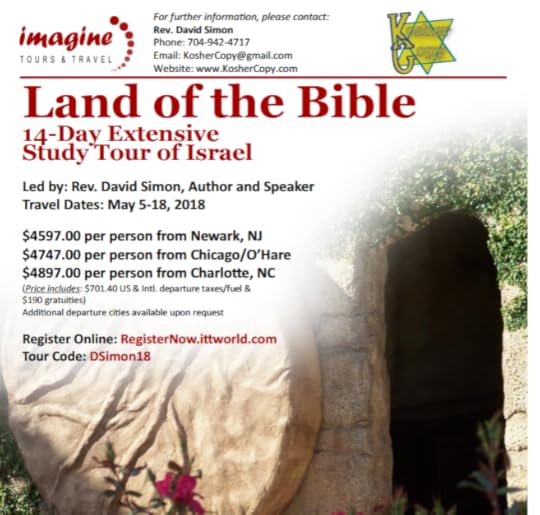
On the completion of our time at En Gedi we will prepare for a swim in the Dead Sea and possibly a visit to Jericho. Fun times are in store for those who join us on our 14 day trip to the Holy Land in May 2018. To sign up, use the link to find more information at www.KosherCopy.com. You will also find links to the trip itinerary and for trip registration.
 The oasis at En Gedi is very ancient. Settlements have been documented along the freshwater streams since the Chalcolithic era or Copper age in Israel. Remains can be found for rich farming communities, Essene schools, Temples, Synagogues, and Roman Villas. It is written that King David used this region as a hide-out, living in caves and partaking of the rich foods found along the cool streams in the area. En Gedi was famous for its Balsam, Date Palms, Henna, and aromatic resins. Solomon wrote, “My beloved is to me a cluster of henna blossoms in the vineyards of Engedi.”
The oasis at En Gedi is very ancient. Settlements have been documented along the freshwater streams since the Chalcolithic era or Copper age in Israel. Remains can be found for rich farming communities, Essene schools, Temples, Synagogues, and Roman Villas. It is written that King David used this region as a hide-out, living in caves and partaking of the rich foods found along the cool streams in the area. En Gedi was famous for its Balsam, Date Palms, Henna, and aromatic resins. Solomon wrote, “My beloved is to me a cluster of henna blossoms in the vineyards of Engedi.”  “David went up from there and lived in the strongholds of En Gedi. After Saul returned from pursuing the Philistines, he was told, ‘David is in the Desert of En Gedi.’ So Saul took three thousand able young men from all Israel and set out to look for David and his men near the Crags of the Wild Goats.” (1 Sam. 24) We will walk up Wadi David during our visit at En Gedi.
“David went up from there and lived in the strongholds of En Gedi. After Saul returned from pursuing the Philistines, he was told, ‘David is in the Desert of En Gedi.’ So Saul took three thousand able young men from all Israel and set out to look for David and his men near the Crags of the Wild Goats.” (1 Sam. 24) We will walk up Wadi David during our visit at En Gedi. We will begin our walk in a picnic area shaded by acacia trees and Christ-thorn jujube. Because of the water there is an abundance of plants and animals along the wadi. We will observe small antelope and Rock Hyrax or Conies under and in the trees.
We will begin our walk in a picnic area shaded by acacia trees and Christ-thorn jujube. Because of the water there is an abundance of plants and animals along the wadi. We will observe small antelope and Rock Hyrax or Conies under and in the trees. After taking time to look at and take photos of the animals we will walk a well laid out trail along the stream. The trail crosses the stream on bridges giving us a closer look at the valley, the plants and the water flowing through shallow pools and trickling over rocks. We will see the caves in which David camped and trails leading to the Judean heights.
After taking time to look at and take photos of the animals we will walk a well laid out trail along the stream. The trail crosses the stream on bridges giving us a closer look at the valley, the plants and the water flowing through shallow pools and trickling over rocks. We will see the caves in which David camped and trails leading to the Judean heights. There are many trails which traverse this Ein Gedi National Park which are well laid out and cover the various wadis in the area. The hike for our group will not be difficult, and there are benches along the way. Climbers who have time and are able can ascend along the Zetuya, Ha issiyyim, B ‘nei Hamoshavim, EnGedi or Yishay ascents to Mt. Zenuya on the desert plateau.
There are many trails which traverse this Ein Gedi National Park which are well laid out and cover the various wadis in the area. The hike for our group will not be difficult, and there are benches along the way. Climbers who have time and are able can ascend along the Zetuya, Ha issiyyim, B ‘nei Hamoshavim, EnGedi or Yishay ascents to Mt. Zenuya on the desert plateau. We will ascend at a much more moderate path along the creek, taking time as we desire to look back along the trail we have traveled. The views are different as we look up the hill toward the waterfall and look downwards toward the Dead Sea in the distance. Those who desire can wander a little and rock climb on marked trails. The rest of us will easily navigate a gradual ascent.
We will ascend at a much more moderate path along the creek, taking time as we desire to look back along the trail we have traveled. The views are different as we look up the hill toward the waterfall and look downwards toward the Dead Sea in the distance. Those who desire can wander a little and rock climb on marked trails. The rest of us will easily navigate a gradual ascent. Our climb will end at David’s waterfall below Dodim’s Cave. We will have time to put or feet in the water, or if prepared we will be able to get into the water and refresh ourselves. From the pool we will be able to stand under the waterfall and look down the canyon to the Dead Sea.
Our climb will end at David’s waterfall below Dodim’s Cave. We will have time to put or feet in the water, or if prepared we will be able to get into the water and refresh ourselves. From the pool we will be able to stand under the waterfall and look down the canyon to the Dead Sea.
On the completion of our time at En Gedi we will prepare for a swim in the Dead Sea and possibly a visit to Jericho. Fun times are in store for those who join us on our 14 day trip to the Holy Land in May 2018. To sign up, use the link to find more information at www.KosherCopy.com. You will also find links to the trip itinerary and for trip registration.
Published on May 11, 2017 03:30
May 5, 2017
Masada
You will see many beautiful and historic sites if you join me during a 14 day trip to the Holy Land in May 2018. One of the fascinating places we will visit is Masada, a location first fortified by Hasmonean Alexander Jannaeus. The fortress was captured by Herod the Great and greatly expanded. We will see Herod’s fortress as we visit the top of Masada.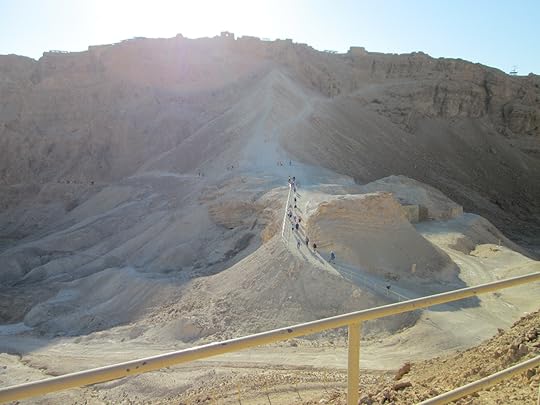 Masada is a geological formation called a horst, or a raised area which sits between two faults. Masada reaches more than a thousand feet above the Dead Sea of the Great Rift Valley fault zone. The top is a large mesa like plateau which contains palaces and housing for soldiers and staff. A large cistern system is contained within the mountain to collect and conserve water for the people who reside there.
Masada is a geological formation called a horst, or a raised area which sits between two faults. Masada reaches more than a thousand feet above the Dead Sea of the Great Rift Valley fault zone. The top is a large mesa like plateau which contains palaces and housing for soldiers and staff. A large cistern system is contained within the mountain to collect and conserve water for the people who reside there. We will approach Masada on our 14 day trip to the Holy Land from the east along the Roman siege ramp. We will see a Roman campground, catapult and a memorial to the Zealots who died in 73 AD.
We will approach Masada on our 14 day trip to the Holy Land from the east along the Roman siege ramp. We will see a Roman campground, catapult and a memorial to the Zealots who died in 73 AD. At the top of the siege ramp we will enter through a gate, observing along the way guard walkways which were outside the walls. The gate is near the Western Palace, which we will tour and see the section of wall which was breached by Rome. Further south is a swimming pool, a southern fort and a mikvah pool.
At the top of the siege ramp we will enter through a gate, observing along the way guard walkways which were outside the walls. The gate is near the Western Palace, which we will tour and see the section of wall which was breached by Rome. Further south is a swimming pool, a southern fort and a mikvah pool. Further north we will visit a barracks and the Synagogue which was used for worship. From this spot we will have an excellent view of the Dead Sea and the far shoreline. We will stop along the Northeastern side of the wall and hear a speech given to the Zealots in 73 AD just before the Romans breached the wall into Masada.
Further north we will visit a barracks and the Synagogue which was used for worship. From this spot we will have an excellent view of the Dead Sea and the far shoreline. We will stop along the Northeastern side of the wall and hear a speech given to the Zealots in 73 AD just before the Romans breached the wall into Masada.  Beyond the Synagogue are storage areas, a bath house, the northern palace and administrative areas. We will have plenty of time to walk around Masada before descending either by the snake path or on a cable car. We will end up in the visitor center near the Dead Sea.
Beyond the Synagogue are storage areas, a bath house, the northern palace and administrative areas. We will have plenty of time to walk around Masada before descending either by the snake path or on a cable car. We will end up in the visitor center near the Dead Sea. From Masada we will drive north along the Dead Sea to En Gedi, Qumran, and a beach where we will float on top of the water. The Dead Sea is lowest habitable place on earth. The air is very dry and oxygen rich. The water is mineral heavy which enables swimmers to float.
From Masada we will drive north along the Dead Sea to En Gedi, Qumran, and a beach where we will float on top of the water. The Dead Sea is lowest habitable place on earth. The air is very dry and oxygen rich. The water is mineral heavy which enables swimmers to float.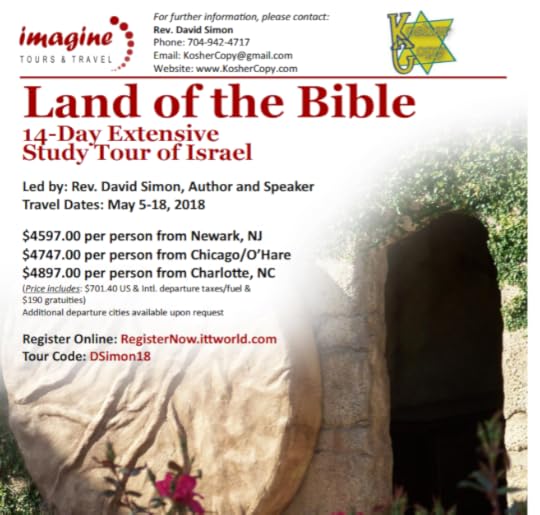 To sign up for the 14 day trip to the Holy Land in May 2018 use the link provided. Visit the Travel Brochure to see our schedule, then visit the registration page to claim a trip discount your initial deposit (details in the travel brochure).
To sign up for the 14 day trip to the Holy Land in May 2018 use the link provided. Visit the Travel Brochure to see our schedule, then visit the registration page to claim a trip discount your initial deposit (details in the travel brochure).

 Masada is a geological formation called a horst, or a raised area which sits between two faults. Masada reaches more than a thousand feet above the Dead Sea of the Great Rift Valley fault zone. The top is a large mesa like plateau which contains palaces and housing for soldiers and staff. A large cistern system is contained within the mountain to collect and conserve water for the people who reside there.
Masada is a geological formation called a horst, or a raised area which sits between two faults. Masada reaches more than a thousand feet above the Dead Sea of the Great Rift Valley fault zone. The top is a large mesa like plateau which contains palaces and housing for soldiers and staff. A large cistern system is contained within the mountain to collect and conserve water for the people who reside there. We will approach Masada on our 14 day trip to the Holy Land from the east along the Roman siege ramp. We will see a Roman campground, catapult and a memorial to the Zealots who died in 73 AD.
We will approach Masada on our 14 day trip to the Holy Land from the east along the Roman siege ramp. We will see a Roman campground, catapult and a memorial to the Zealots who died in 73 AD. At the top of the siege ramp we will enter through a gate, observing along the way guard walkways which were outside the walls. The gate is near the Western Palace, which we will tour and see the section of wall which was breached by Rome. Further south is a swimming pool, a southern fort and a mikvah pool.
At the top of the siege ramp we will enter through a gate, observing along the way guard walkways which were outside the walls. The gate is near the Western Palace, which we will tour and see the section of wall which was breached by Rome. Further south is a swimming pool, a southern fort and a mikvah pool. Further north we will visit a barracks and the Synagogue which was used for worship. From this spot we will have an excellent view of the Dead Sea and the far shoreline. We will stop along the Northeastern side of the wall and hear a speech given to the Zealots in 73 AD just before the Romans breached the wall into Masada.
Further north we will visit a barracks and the Synagogue which was used for worship. From this spot we will have an excellent view of the Dead Sea and the far shoreline. We will stop along the Northeastern side of the wall and hear a speech given to the Zealots in 73 AD just before the Romans breached the wall into Masada.  Beyond the Synagogue are storage areas, a bath house, the northern palace and administrative areas. We will have plenty of time to walk around Masada before descending either by the snake path or on a cable car. We will end up in the visitor center near the Dead Sea.
Beyond the Synagogue are storage areas, a bath house, the northern palace and administrative areas. We will have plenty of time to walk around Masada before descending either by the snake path or on a cable car. We will end up in the visitor center near the Dead Sea. From Masada we will drive north along the Dead Sea to En Gedi, Qumran, and a beach where we will float on top of the water. The Dead Sea is lowest habitable place on earth. The air is very dry and oxygen rich. The water is mineral heavy which enables swimmers to float.
From Masada we will drive north along the Dead Sea to En Gedi, Qumran, and a beach where we will float on top of the water. The Dead Sea is lowest habitable place on earth. The air is very dry and oxygen rich. The water is mineral heavy which enables swimmers to float. To sign up for the 14 day trip to the Holy Land in May 2018 use the link provided. Visit the Travel Brochure to see our schedule, then visit the registration page to claim a trip discount your initial deposit (details in the travel brochure).
To sign up for the 14 day trip to the Holy Land in May 2018 use the link provided. Visit the Travel Brochure to see our schedule, then visit the registration page to claim a trip discount your initial deposit (details in the travel brochure). 
Published on May 05, 2017 03:30
April 29, 2017
Riding Camels
One of the highlights of our 14 day trip to the Holy Land in May 2018 will be a camel ride. During our time in the Negev we will visit Beer Sheva, where Abraham settled, Sde Boker, where David Ben Gurion settled, and Arad, a town of the Nabateans. During our tour through the desert we will experience its vastness, isolation and beauty.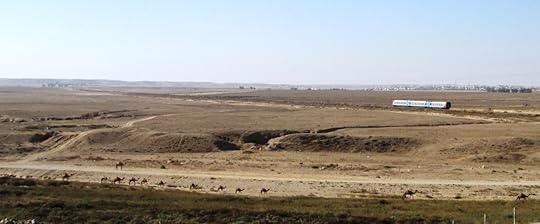 We will spend the first night of our time in the Negev at Be’er Sheva, the largest city in the area, boasting a population of over 250,000 people. We will drive past the large university and spend the night in a beautiful hotel. On the second night in the desert we will spend the night in a Bedouin village to experience the isolation and brilliance of nighttime away from city lights.
We will spend the first night of our time in the Negev at Be’er Sheva, the largest city in the area, boasting a population of over 250,000 people. We will drive past the large university and spend the night in a beautiful hotel. On the second night in the desert we will spend the night in a Bedouin village to experience the isolation and brilliance of nighttime away from city lights.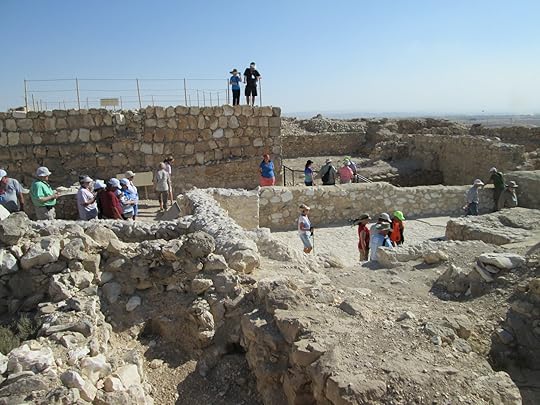 After our visit to Arad we will board our bus and drive to Kana`im valley. We will pull up outside a Bedouin compound which overlooks Wadi T'zelim and Wadi Rahaf and see both asses and camels. In a display of Bedouin hospitality we will be offered a camel ride through the sands of the desert.
After our visit to Arad we will board our bus and drive to Kana`im valley. We will pull up outside a Bedouin compound which overlooks Wadi T'zelim and Wadi Rahaf and see both asses and camels. In a display of Bedouin hospitality we will be offered a camel ride through the sands of the desert. 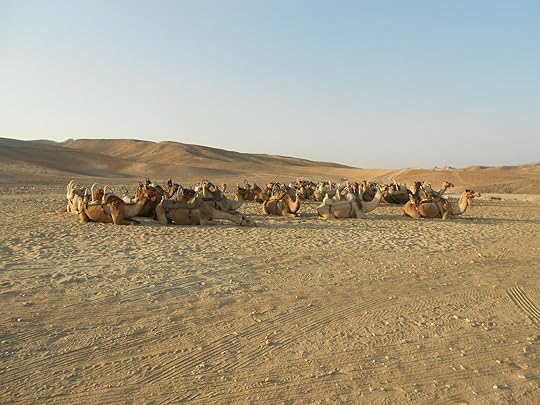 The camels will bring a wonderful conclusion to a day of traveling in the Negev. During our time in the Negev we will visit and spend the night at a Bedouin compound in the Kana`im valley. The camels will be settled and at the urging of a camel-puller so we can climb to the top of the hump and onto the saddle. The camels will then be encouraged to rise and in formation will be led across the sand. We will enjoy our camel ride and reminisce about earlier caravans and camel rides of the Bible.
The camels will bring a wonderful conclusion to a day of traveling in the Negev. During our time in the Negev we will visit and spend the night at a Bedouin compound in the Kana`im valley. The camels will be settled and at the urging of a camel-puller so we can climb to the top of the hump and onto the saddle. The camels will then be encouraged to rise and in formation will be led across the sand. We will enjoy our camel ride and reminisce about earlier caravans and camel rides of the Bible.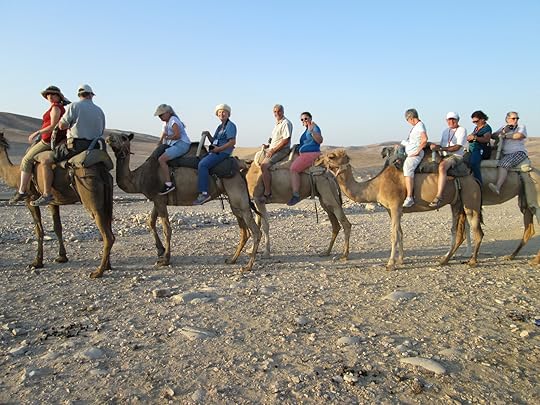 After our ride we will proceed into Kfar Hanokdim where we will be directed to our lodging and to dinner. This compound is an upscale Arab village with permanent dwellings and bunk beds. We will lay out our bedding, wash our hands and enter a dining hall for a traditional Bedouin followed by stories of the desert and entertainment. Dinner will include Magluba, a rice and vegetable dish served on thin pita breads, a variety of salads and grilled meats, including Kebab and crispy chicken wings.
After our ride we will proceed into Kfar Hanokdim where we will be directed to our lodging and to dinner. This compound is an upscale Arab village with permanent dwellings and bunk beds. We will lay out our bedding, wash our hands and enter a dining hall for a traditional Bedouin followed by stories of the desert and entertainment. Dinner will include Magluba, a rice and vegetable dish served on thin pita breads, a variety of salads and grilled meats, including Kebab and crispy chicken wings.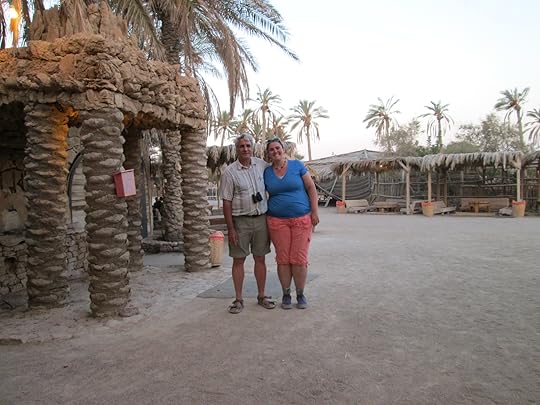 Following dinner we will go into the desert for a time of devotion. It should be a brilliant night as we will be close to the new moon. This will give us a great look at the stars overhead. The experience should be unforgettable.
Following dinner we will go into the desert for a time of devotion. It should be a brilliant night as we will be close to the new moon. This will give us a great look at the stars overhead. The experience should be unforgettable.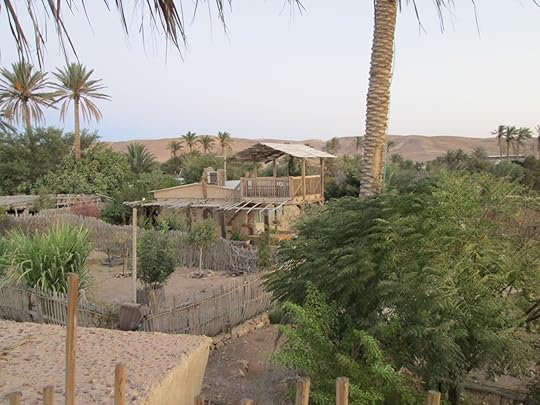 You are invited to join us on our 14 day trip to the Holy Land in May 2018. For full details in a brochure visit this webpage. To sign up for the trip please use the form at this web page. I hope you will go with us to Israel. The experience is one of a lifetime. Many sites will be visited during our trip which are bypassed on other trips.
You are invited to join us on our 14 day trip to the Holy Land in May 2018. For full details in a brochure visit this webpage. To sign up for the trip please use the form at this web page. I hope you will go with us to Israel. The experience is one of a lifetime. Many sites will be visited during our trip which are bypassed on other trips.
 We will spend the first night of our time in the Negev at Be’er Sheva, the largest city in the area, boasting a population of over 250,000 people. We will drive past the large university and spend the night in a beautiful hotel. On the second night in the desert we will spend the night in a Bedouin village to experience the isolation and brilliance of nighttime away from city lights.
We will spend the first night of our time in the Negev at Be’er Sheva, the largest city in the area, boasting a population of over 250,000 people. We will drive past the large university and spend the night in a beautiful hotel. On the second night in the desert we will spend the night in a Bedouin village to experience the isolation and brilliance of nighttime away from city lights. After our visit to Arad we will board our bus and drive to Kana`im valley. We will pull up outside a Bedouin compound which overlooks Wadi T'zelim and Wadi Rahaf and see both asses and camels. In a display of Bedouin hospitality we will be offered a camel ride through the sands of the desert.
After our visit to Arad we will board our bus and drive to Kana`im valley. We will pull up outside a Bedouin compound which overlooks Wadi T'zelim and Wadi Rahaf and see both asses and camels. In a display of Bedouin hospitality we will be offered a camel ride through the sands of the desert.  The camels will bring a wonderful conclusion to a day of traveling in the Negev. During our time in the Negev we will visit and spend the night at a Bedouin compound in the Kana`im valley. The camels will be settled and at the urging of a camel-puller so we can climb to the top of the hump and onto the saddle. The camels will then be encouraged to rise and in formation will be led across the sand. We will enjoy our camel ride and reminisce about earlier caravans and camel rides of the Bible.
The camels will bring a wonderful conclusion to a day of traveling in the Negev. During our time in the Negev we will visit and spend the night at a Bedouin compound in the Kana`im valley. The camels will be settled and at the urging of a camel-puller so we can climb to the top of the hump and onto the saddle. The camels will then be encouraged to rise and in formation will be led across the sand. We will enjoy our camel ride and reminisce about earlier caravans and camel rides of the Bible. After our ride we will proceed into Kfar Hanokdim where we will be directed to our lodging and to dinner. This compound is an upscale Arab village with permanent dwellings and bunk beds. We will lay out our bedding, wash our hands and enter a dining hall for a traditional Bedouin followed by stories of the desert and entertainment. Dinner will include Magluba, a rice and vegetable dish served on thin pita breads, a variety of salads and grilled meats, including Kebab and crispy chicken wings.
After our ride we will proceed into Kfar Hanokdim where we will be directed to our lodging and to dinner. This compound is an upscale Arab village with permanent dwellings and bunk beds. We will lay out our bedding, wash our hands and enter a dining hall for a traditional Bedouin followed by stories of the desert and entertainment. Dinner will include Magluba, a rice and vegetable dish served on thin pita breads, a variety of salads and grilled meats, including Kebab and crispy chicken wings. Following dinner we will go into the desert for a time of devotion. It should be a brilliant night as we will be close to the new moon. This will give us a great look at the stars overhead. The experience should be unforgettable.
Following dinner we will go into the desert for a time of devotion. It should be a brilliant night as we will be close to the new moon. This will give us a great look at the stars overhead. The experience should be unforgettable. You are invited to join us on our 14 day trip to the Holy Land in May 2018. For full details in a brochure visit this webpage. To sign up for the trip please use the form at this web page. I hope you will go with us to Israel. The experience is one of a lifetime. Many sites will be visited during our trip which are bypassed on other trips.
You are invited to join us on our 14 day trip to the Holy Land in May 2018. For full details in a brochure visit this webpage. To sign up for the trip please use the form at this web page. I hope you will go with us to Israel. The experience is one of a lifetime. Many sites will be visited during our trip which are bypassed on other trips.
Published on April 29, 2017 03:39
April 28, 2017
Patriotism in Tel Aviv
Next year I will be leading a tour group on a 14 day trip to the Holy Land. We will be visiting Tel-Aviv during the Seventieth Anniversary celebration of Israel’s birth as a modern nation. We will be visiting Independence Hall and many historic sites where we can participate in the celebration. I am inviting all my readers to join me on this unique tour of Israel. To see the full agenda or to sign up, click the links. You will be rewarded through personal discoveries and experiences by going on this journey.The beginnings of the modern state of Israel began in the hearts and minds of several men and women in nineteenth century Europe. Pogroms in Russia drew French banker Baron Edmond Rothschild’s attention to Israel in the 1880s. He used a new idea to drain swamps on the plain of Sharon, starting agricultural communes where he could resettle Russian refugees. Farms were started in Rishon-Le-Zion, Petach Tikvah, Zichron Yaakov, Hederah, Rosh Pinah and Yesod Ha Ma’aleh which drew Jewish settlers from Russia, France, Germany, the Pale, and other areas of Europe.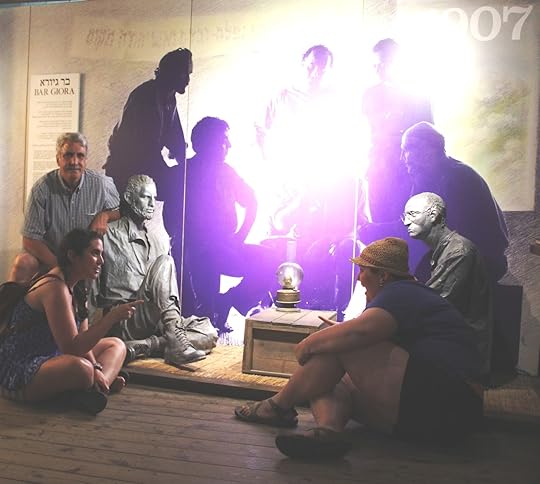 Theodor (Binyamin Ze'ev) Herzl, a writer, playwright, and journalist, experienced anti-semitism while at the University of Vienna. He also saw that Russians displaced by the pogroms needed a place of refuge. In 1894 he wrote a play entitled “The Ghetto,” first of several works which birthed a movement called Zionism. This movement advanced a dream to establish a homeland for the Jewish people in Palestine, and consequently the settlement efforts.
Theodor (Binyamin Ze'ev) Herzl, a writer, playwright, and journalist, experienced anti-semitism while at the University of Vienna. He also saw that Russians displaced by the pogroms needed a place of refuge. In 1894 he wrote a play entitled “The Ghetto,” first of several works which birthed a movement called Zionism. This movement advanced a dream to establish a homeland for the Jewish people in Palestine, and consequently the settlement efforts. 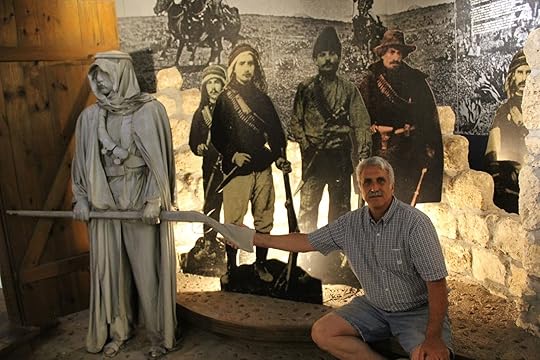 As the movement of Jewish people to Israel increased in population, it angered Arab shepherds who used the land for grazing. They staged raids into Jewish compounds and destroyed crops. A primitive police force and small militia arose in the early settlements out of necessity. The farmers learned to take up arms, but the raids could come any time of day or night and the settlers realized that preparation and training with guns was not enough. They built walls first, then guard towers around their villages - simple throwbacks to the medieval castles of Europe or the walled cities of ancient Israel.
As the movement of Jewish people to Israel increased in population, it angered Arab shepherds who used the land for grazing. They staged raids into Jewish compounds and destroyed crops. A primitive police force and small militia arose in the early settlements out of necessity. The farmers learned to take up arms, but the raids could come any time of day or night and the settlers realized that preparation and training with guns was not enough. They built walls first, then guard towers around their villages - simple throwbacks to the medieval castles of Europe or the walled cities of ancient Israel.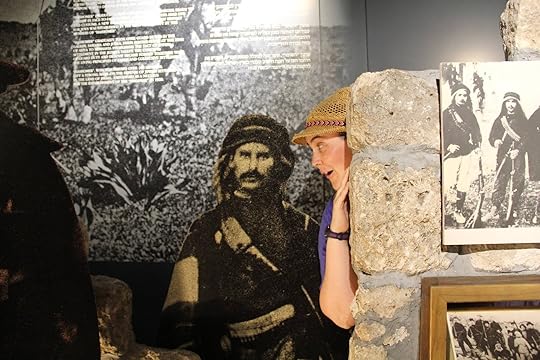 Just like in the days when Nehemiah was building the walls of Jerusalem, guards were posted in the fields by day and on the guard towers at night, watching for irregular but deadly Arab attacks. The early military included people like Israel Shochat, Yitzhak Ben-Zvi, Mendel Portugali, Israel Giladi, Alexander Zaid, Yehezkel Hankin, Yehezkel Nissanov, and Moshe Givoni, who realized that simple protection was not enough to halt the raids. They formed a secret a police organization called Bar-Giora to share information and formulate protective strategies. They went undercover as Arab shepherds in order to spy and thereby uncover potential attacks before they occurred.
Just like in the days when Nehemiah was building the walls of Jerusalem, guards were posted in the fields by day and on the guard towers at night, watching for irregular but deadly Arab attacks. The early military included people like Israel Shochat, Yitzhak Ben-Zvi, Mendel Portugali, Israel Giladi, Alexander Zaid, Yehezkel Hankin, Yehezkel Nissanov, and Moshe Givoni, who realized that simple protection was not enough to halt the raids. They formed a secret a police organization called Bar-Giora to share information and formulate protective strategies. They went undercover as Arab shepherds in order to spy and thereby uncover potential attacks before they occurred. The early movement developed into several more assertive organizations by the twentieth century including the Ha-Shomer (Guild of Watchman), the Haganah, Etzel, and Irgun. These movements protected settlers against Arab uprisings (such as the the events of 1922 and 1929), continued and stepped up the training offered to community police organizations, and made preemptive strikes against terror-based groups in Palestine and beyond.
The early movement developed into several more assertive organizations by the twentieth century including the Ha-Shomer (Guild of Watchman), the Haganah, Etzel, and Irgun. These movements protected settlers against Arab uprisings (such as the the events of 1922 and 1929), continued and stepped up the training offered to community police organizations, and made preemptive strikes against terror-based groups in Palestine and beyond. After World War I, the occupation of Palestine was transferred from the Ottoman Empire to Great Britain. The English were sympathetic to the Jewish settlers at first and issued a policy called the Balfour Declaration. The Arabs pressured their new rulers to stem the immigration of refugees and Zionist farmers who were changing their land. The British government then issued “White Papers,” or policies which reduced (1921), limited (1930), and then banned (1939) Jewish immigration. These papers incited Jewish resistance and necessitated methods to smuggle Jewish refugees into the land. The Haganah and other organizations declared war on England.
After World War I, the occupation of Palestine was transferred from the Ottoman Empire to Great Britain. The English were sympathetic to the Jewish settlers at first and issued a policy called the Balfour Declaration. The Arabs pressured their new rulers to stem the immigration of refugees and Zionist farmers who were changing their land. The British government then issued “White Papers,” or policies which reduced (1921), limited (1930), and then banned (1939) Jewish immigration. These papers incited Jewish resistance and necessitated methods to smuggle Jewish refugees into the land. The Haganah and other organizations declared war on England.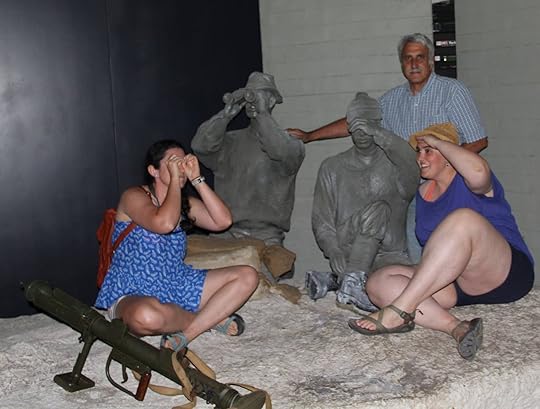 But the war effort was stalled as the power of a new enemy overshadowed skirmishes taking place in Zion. Jews who were formally at war with England joined British forces to defeat Adolf Hitler and the Nazis. Many stories of valor can be told of Jewish soldiers who cooperated with the British in World War II military efforts while simultaneously breaking British leadership’s anti-Jewish refugee laws by illegally smuggling concentration camp escapees into Israel.
But the war effort was stalled as the power of a new enemy overshadowed skirmishes taking place in Zion. Jews who were formally at war with England joined British forces to defeat Adolf Hitler and the Nazis. Many stories of valor can be told of Jewish soldiers who cooperated with the British in World War II military efforts while simultaneously breaking British leadership’s anti-Jewish refugee laws by illegally smuggling concentration camp escapees into Israel.
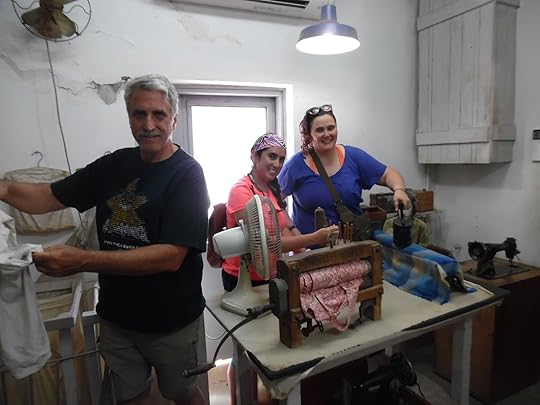 As World War II came to an end the Haganah renewed their war with England. They planned and moved forward with resistance against British colonial rule. They also worked to bring displaced Jews who survived both war and concentration camps to the land as illegal refugees (with an obvious need and nowhere else to go - other countries, including the U.S., were also turning away Jews who had escaped the horrors of the Holocaust alive). Zionists talked about a Jewish homeland with a government of their own in order to protect their people from the winds of foreign policy.
As World War II came to an end the Haganah renewed their war with England. They planned and moved forward with resistance against British colonial rule. They also worked to bring displaced Jews who survived both war and concentration camps to the land as illegal refugees (with an obvious need and nowhere else to go - other countries, including the U.S., were also turning away Jews who had escaped the horrors of the Holocaust alive). Zionists talked about a Jewish homeland with a government of their own in order to protect their people from the winds of foreign policy. 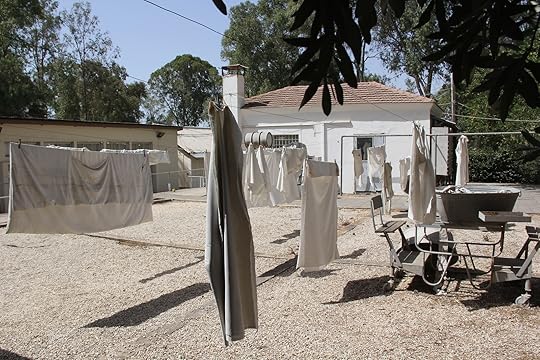 The Haganah built secret munitions factory and storage facilities to fight against Great Britain. We visited one such underground facility during our 2016 trip to Israel. We saw the laundry and bakery of Machon Ayalon, an agricultural kibbutz at Rehovot which hid an underground bullet factory.
The Haganah built secret munitions factory and storage facilities to fight against Great Britain. We visited one such underground facility during our 2016 trip to Israel. We saw the laundry and bakery of Machon Ayalon, an agricultural kibbutz at Rehovot which hid an underground bullet factory.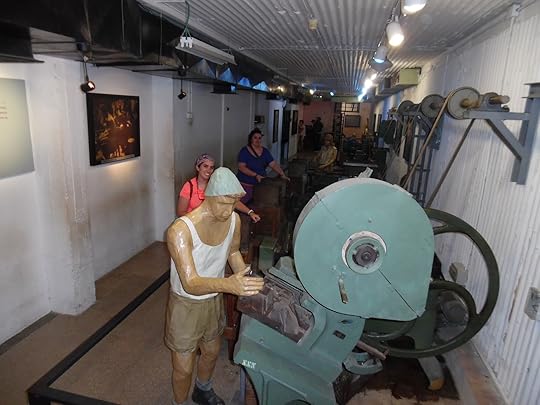 Similar facilities were built across “Eretz Yisrael” (the land of Israel) in order to supply the rebellion and give birth to the new Jewish homeland.
Similar facilities were built across “Eretz Yisrael” (the land of Israel) in order to supply the rebellion and give birth to the new Jewish homeland.  Enlistment efforts were made to build an army and stage resistance which would lead to the independence of a new (yet ancient) Jewish homeland. Attacks were made on communication and transportation facilities in order to interrupt the ability of the British government and soldiers to effectively govern the land. These attacks were made at night in order to prevent loss of life for both the Jewish army and the British who operated these necessary services.
Enlistment efforts were made to build an army and stage resistance which would lead to the independence of a new (yet ancient) Jewish homeland. Attacks were made on communication and transportation facilities in order to interrupt the ability of the British government and soldiers to effectively govern the land. These attacks were made at night in order to prevent loss of life for both the Jewish army and the British who operated these necessary services.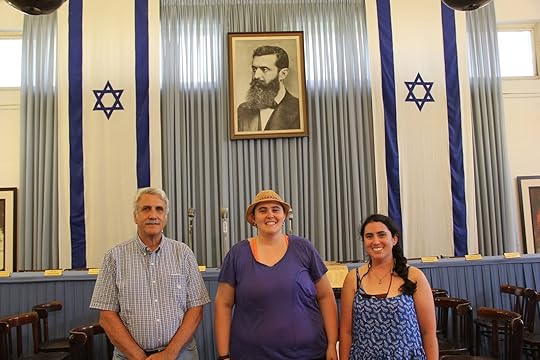 Jewish resistance was effective. England could not hold the country on their own and asked the United Nations to chart a course for the future. A resolution was drawn up recommending the creation of independent Arab and Jewish States. The Plan called for separate governments but economic union between two proposed states. At midnight on May 14, 1948, England announced their rule of Palestine would end and two new nations could be established.
Jewish resistance was effective. England could not hold the country on their own and asked the United Nations to chart a course for the future. A resolution was drawn up recommending the creation of independent Arab and Jewish States. The Plan called for separate governments but economic union between two proposed states. At midnight on May 14, 1948, England announced their rule of Palestine would end and two new nations could be established. 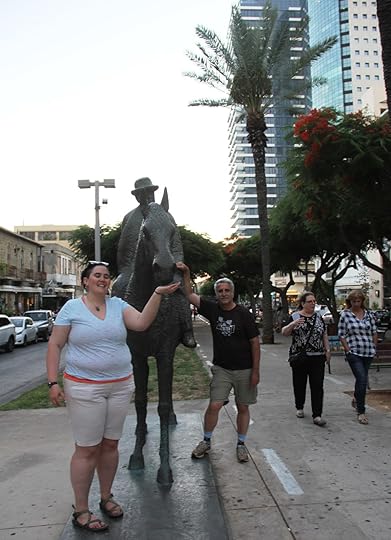 The Jewish people seized the opportunity to establish a new government. Formal organization took place in the home of Meir Dizengoff to sign all necessary papers and to declare independence for the nation of Israel.
The Jewish people seized the opportunity to establish a new government. Formal organization took place in the home of Meir Dizengoff to sign all necessary papers and to declare independence for the nation of Israel. 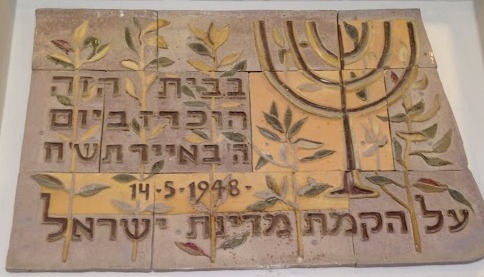 There is much more to this story which I hope can be shared on a trip to Israel May 5-18 next year. You are invited to come on this trip - information is found at this link and you can sign up by clicking this link. On our first day in Israel we will visit the Palmach Museum to learn about the Jewish resistance movement. We will also visit the former home of Meir Dizengoff in order to understand the Jewish desire for their own homeland and to catch the spirit of Zionism.
There is much more to this story which I hope can be shared on a trip to Israel May 5-18 next year. You are invited to come on this trip - information is found at this link and you can sign up by clicking this link. On our first day in Israel we will visit the Palmach Museum to learn about the Jewish resistance movement. We will also visit the former home of Meir Dizengoff in order to understand the Jewish desire for their own homeland and to catch the spirit of Zionism.
During the following days of our trip we will visit biblical sites, make new friends, and tell stories of faith and patriotism. This trip is a tour for people who wish to understand “Eretz Yisrael” (the land of Israel) from both Jewish and Christian perspectives. It will be life changing for all who choose to participate.
 Theodor (Binyamin Ze'ev) Herzl, a writer, playwright, and journalist, experienced anti-semitism while at the University of Vienna. He also saw that Russians displaced by the pogroms needed a place of refuge. In 1894 he wrote a play entitled “The Ghetto,” first of several works which birthed a movement called Zionism. This movement advanced a dream to establish a homeland for the Jewish people in Palestine, and consequently the settlement efforts.
Theodor (Binyamin Ze'ev) Herzl, a writer, playwright, and journalist, experienced anti-semitism while at the University of Vienna. He also saw that Russians displaced by the pogroms needed a place of refuge. In 1894 he wrote a play entitled “The Ghetto,” first of several works which birthed a movement called Zionism. This movement advanced a dream to establish a homeland for the Jewish people in Palestine, and consequently the settlement efforts.  As the movement of Jewish people to Israel increased in population, it angered Arab shepherds who used the land for grazing. They staged raids into Jewish compounds and destroyed crops. A primitive police force and small militia arose in the early settlements out of necessity. The farmers learned to take up arms, but the raids could come any time of day or night and the settlers realized that preparation and training with guns was not enough. They built walls first, then guard towers around their villages - simple throwbacks to the medieval castles of Europe or the walled cities of ancient Israel.
As the movement of Jewish people to Israel increased in population, it angered Arab shepherds who used the land for grazing. They staged raids into Jewish compounds and destroyed crops. A primitive police force and small militia arose in the early settlements out of necessity. The farmers learned to take up arms, but the raids could come any time of day or night and the settlers realized that preparation and training with guns was not enough. They built walls first, then guard towers around their villages - simple throwbacks to the medieval castles of Europe or the walled cities of ancient Israel. Just like in the days when Nehemiah was building the walls of Jerusalem, guards were posted in the fields by day and on the guard towers at night, watching for irregular but deadly Arab attacks. The early military included people like Israel Shochat, Yitzhak Ben-Zvi, Mendel Portugali, Israel Giladi, Alexander Zaid, Yehezkel Hankin, Yehezkel Nissanov, and Moshe Givoni, who realized that simple protection was not enough to halt the raids. They formed a secret a police organization called Bar-Giora to share information and formulate protective strategies. They went undercover as Arab shepherds in order to spy and thereby uncover potential attacks before they occurred.
Just like in the days when Nehemiah was building the walls of Jerusalem, guards were posted in the fields by day and on the guard towers at night, watching for irregular but deadly Arab attacks. The early military included people like Israel Shochat, Yitzhak Ben-Zvi, Mendel Portugali, Israel Giladi, Alexander Zaid, Yehezkel Hankin, Yehezkel Nissanov, and Moshe Givoni, who realized that simple protection was not enough to halt the raids. They formed a secret a police organization called Bar-Giora to share information and formulate protective strategies. They went undercover as Arab shepherds in order to spy and thereby uncover potential attacks before they occurred. The early movement developed into several more assertive organizations by the twentieth century including the Ha-Shomer (Guild of Watchman), the Haganah, Etzel, and Irgun. These movements protected settlers against Arab uprisings (such as the the events of 1922 and 1929), continued and stepped up the training offered to community police organizations, and made preemptive strikes against terror-based groups in Palestine and beyond.
The early movement developed into several more assertive organizations by the twentieth century including the Ha-Shomer (Guild of Watchman), the Haganah, Etzel, and Irgun. These movements protected settlers against Arab uprisings (such as the the events of 1922 and 1929), continued and stepped up the training offered to community police organizations, and made preemptive strikes against terror-based groups in Palestine and beyond. After World War I, the occupation of Palestine was transferred from the Ottoman Empire to Great Britain. The English were sympathetic to the Jewish settlers at first and issued a policy called the Balfour Declaration. The Arabs pressured their new rulers to stem the immigration of refugees and Zionist farmers who were changing their land. The British government then issued “White Papers,” or policies which reduced (1921), limited (1930), and then banned (1939) Jewish immigration. These papers incited Jewish resistance and necessitated methods to smuggle Jewish refugees into the land. The Haganah and other organizations declared war on England.
After World War I, the occupation of Palestine was transferred from the Ottoman Empire to Great Britain. The English were sympathetic to the Jewish settlers at first and issued a policy called the Balfour Declaration. The Arabs pressured their new rulers to stem the immigration of refugees and Zionist farmers who were changing their land. The British government then issued “White Papers,” or policies which reduced (1921), limited (1930), and then banned (1939) Jewish immigration. These papers incited Jewish resistance and necessitated methods to smuggle Jewish refugees into the land. The Haganah and other organizations declared war on England. But the war effort was stalled as the power of a new enemy overshadowed skirmishes taking place in Zion. Jews who were formally at war with England joined British forces to defeat Adolf Hitler and the Nazis. Many stories of valor can be told of Jewish soldiers who cooperated with the British in World War II military efforts while simultaneously breaking British leadership’s anti-Jewish refugee laws by illegally smuggling concentration camp escapees into Israel.
But the war effort was stalled as the power of a new enemy overshadowed skirmishes taking place in Zion. Jews who were formally at war with England joined British forces to defeat Adolf Hitler and the Nazis. Many stories of valor can be told of Jewish soldiers who cooperated with the British in World War II military efforts while simultaneously breaking British leadership’s anti-Jewish refugee laws by illegally smuggling concentration camp escapees into Israel.
 As World War II came to an end the Haganah renewed their war with England. They planned and moved forward with resistance against British colonial rule. They also worked to bring displaced Jews who survived both war and concentration camps to the land as illegal refugees (with an obvious need and nowhere else to go - other countries, including the U.S., were also turning away Jews who had escaped the horrors of the Holocaust alive). Zionists talked about a Jewish homeland with a government of their own in order to protect their people from the winds of foreign policy.
As World War II came to an end the Haganah renewed their war with England. They planned and moved forward with resistance against British colonial rule. They also worked to bring displaced Jews who survived both war and concentration camps to the land as illegal refugees (with an obvious need and nowhere else to go - other countries, including the U.S., were also turning away Jews who had escaped the horrors of the Holocaust alive). Zionists talked about a Jewish homeland with a government of their own in order to protect their people from the winds of foreign policy.  The Haganah built secret munitions factory and storage facilities to fight against Great Britain. We visited one such underground facility during our 2016 trip to Israel. We saw the laundry and bakery of Machon Ayalon, an agricultural kibbutz at Rehovot which hid an underground bullet factory.
The Haganah built secret munitions factory and storage facilities to fight against Great Britain. We visited one such underground facility during our 2016 trip to Israel. We saw the laundry and bakery of Machon Ayalon, an agricultural kibbutz at Rehovot which hid an underground bullet factory. Similar facilities were built across “Eretz Yisrael” (the land of Israel) in order to supply the rebellion and give birth to the new Jewish homeland.
Similar facilities were built across “Eretz Yisrael” (the land of Israel) in order to supply the rebellion and give birth to the new Jewish homeland.  Enlistment efforts were made to build an army and stage resistance which would lead to the independence of a new (yet ancient) Jewish homeland. Attacks were made on communication and transportation facilities in order to interrupt the ability of the British government and soldiers to effectively govern the land. These attacks were made at night in order to prevent loss of life for both the Jewish army and the British who operated these necessary services.
Enlistment efforts were made to build an army and stage resistance which would lead to the independence of a new (yet ancient) Jewish homeland. Attacks were made on communication and transportation facilities in order to interrupt the ability of the British government and soldiers to effectively govern the land. These attacks were made at night in order to prevent loss of life for both the Jewish army and the British who operated these necessary services. Jewish resistance was effective. England could not hold the country on their own and asked the United Nations to chart a course for the future. A resolution was drawn up recommending the creation of independent Arab and Jewish States. The Plan called for separate governments but economic union between two proposed states. At midnight on May 14, 1948, England announced their rule of Palestine would end and two new nations could be established.
Jewish resistance was effective. England could not hold the country on their own and asked the United Nations to chart a course for the future. A resolution was drawn up recommending the creation of independent Arab and Jewish States. The Plan called for separate governments but economic union between two proposed states. At midnight on May 14, 1948, England announced their rule of Palestine would end and two new nations could be established.  The Jewish people seized the opportunity to establish a new government. Formal organization took place in the home of Meir Dizengoff to sign all necessary papers and to declare independence for the nation of Israel.
The Jewish people seized the opportunity to establish a new government. Formal organization took place in the home of Meir Dizengoff to sign all necessary papers and to declare independence for the nation of Israel.  There is much more to this story which I hope can be shared on a trip to Israel May 5-18 next year. You are invited to come on this trip - information is found at this link and you can sign up by clicking this link. On our first day in Israel we will visit the Palmach Museum to learn about the Jewish resistance movement. We will also visit the former home of Meir Dizengoff in order to understand the Jewish desire for their own homeland and to catch the spirit of Zionism.
There is much more to this story which I hope can be shared on a trip to Israel May 5-18 next year. You are invited to come on this trip - information is found at this link and you can sign up by clicking this link. On our first day in Israel we will visit the Palmach Museum to learn about the Jewish resistance movement. We will also visit the former home of Meir Dizengoff in order to understand the Jewish desire for their own homeland and to catch the spirit of Zionism.
During the following days of our trip we will visit biblical sites, make new friends, and tell stories of faith and patriotism. This trip is a tour for people who wish to understand “Eretz Yisrael” (the land of Israel) from both Jewish and Christian perspectives. It will be life changing for all who choose to participate.
Published on April 28, 2017 03:30
April 21, 2017
Hiking along En Avedat Canyon
Adventure as we hike in some of the most beautiful terrain is on tap for us on the fourth day of a 14 day trip to the Holy Land in May 2018. As we visit En Avedat National Park we will be walking on the edge of the Desert of Zin where Moses and the Israelites journeyed as they exited Egypt. We will traverse Wadi Zin from a wide valley below Sde Boker through the ravine to the Avadat heights.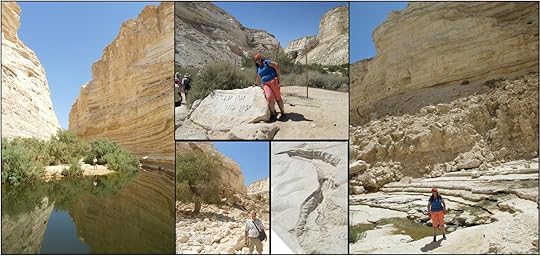 Views from a hike through the lower Wadi AvedatThe Bible tells us the spies, “went up and explored the land from the Desert of Zin as far as Rehob, toward Lebo Hamath. They went up through the Negev and came to Hebron … When they reached the Valley of Eshkol, they cut off a branch bearing a single cluster of grapes. Two of them carried it on a pole between them, along with some pomegranates and figs.” (Nu 13) Ein Avedat is on a major road which leads from the south to the Judean hill country.
Views from a hike through the lower Wadi AvedatThe Bible tells us the spies, “went up and explored the land from the Desert of Zin as far as Rehob, toward Lebo Hamath. They went up through the Negev and came to Hebron … When they reached the Valley of Eshkol, they cut off a branch bearing a single cluster of grapes. Two of them carried it on a pole between them, along with some pomegranates and figs.” (Nu 13) Ein Avedat is on a major road which leads from the south to the Judean hill country.  There are many modes of transportation in the Negev including Trains and CamelsWe will follow the return route of the twelve spies as we travel from Beer Sheba to Sde Boker and Avadat. The road continues to Eilat on the Red Sea and then to the west (traditional site of Mt. Sinai) and to the east (south to Arabia and Midian). The road runs through the desert. Our stopping point is an oasis where surely the spies stopped to drink some water.
There are many modes of transportation in the Negev including Trains and CamelsWe will follow the return route of the twelve spies as we travel from Beer Sheba to Sde Boker and Avadat. The road continues to Eilat on the Red Sea and then to the west (traditional site of Mt. Sinai) and to the east (south to Arabia and Midian). The road runs through the desert. Our stopping point is an oasis where surely the spies stopped to drink some water.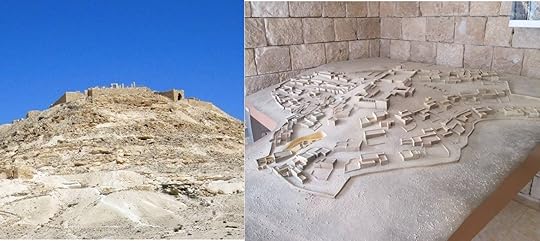 This is a picture and a map of ruins at AvadatThe Nabateans traversed this area in the first centuries BC and AD. They carried various types of merchandise along what is known as the incense route including myrrh and frankincense. Abdah or Obodat was built by the Nabateans and became their second most important city after Petra. Springs in the area allowed agricultural development which included diversion streams and dams. With the demise of the Nabateans other people continued to live and farm the area through the Roman and Byzantine eras. It is said Nabataean King Obodas I (96 to 85 BC) after whom the town is named was buried in the area.
This is a picture and a map of ruins at AvadatThe Nabateans traversed this area in the first centuries BC and AD. They carried various types of merchandise along what is known as the incense route including myrrh and frankincense. Abdah or Obodat was built by the Nabateans and became their second most important city after Petra. Springs in the area allowed agricultural development which included diversion streams and dams. With the demise of the Nabateans other people continued to live and farm the area through the Roman and Byzantine eras. It is said Nabataean King Obodas I (96 to 85 BC) after whom the town is named was buried in the area.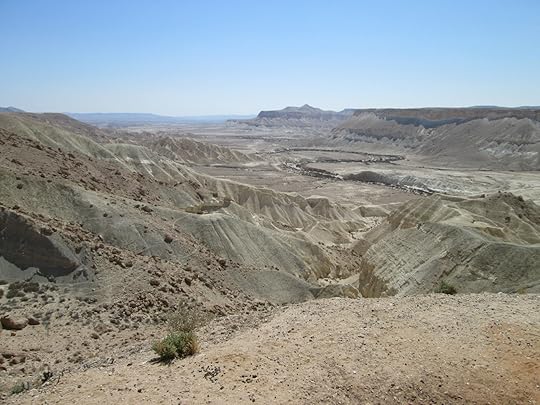 This is the view of Wadi Zin from Sde BokerWe will approach Wadi Avadat by way of Sde Boker. The Kibbutz here is famous for carrying out the Zionist dream of making the desert bloom. David Ben Gurion, Israel’s first Prime Minister lived and was buried here in a grave that overlooks the wide valley through which the stream flows. From the gravesite we will look down on Wadi Zin where our hike will begin.
This is the view of Wadi Zin from Sde BokerWe will approach Wadi Avadat by way of Sde Boker. The Kibbutz here is famous for carrying out the Zionist dream of making the desert bloom. David Ben Gurion, Israel’s first Prime Minister lived and was buried here in a grave that overlooks the wide valley through which the stream flows. From the gravesite we will look down on Wadi Zin where our hike will begin. Ibex at Sde Boker with Wadi Zin in the backgroundWe will also see Ibex and other wildlife native to the area. Psalm 104:18 could speak of animals in the area. It says, “The high mountains belong to the wild goats; the crags are a refuge for the hyrax.” We will see lizards, fish and some birds. Swifts, wheatears, partridges, chukars, babblers, desert swallows, rock doves and vultures fly above the valley. Vols and the desert dormouse wander the trail by night.
Ibex at Sde Boker with Wadi Zin in the backgroundWe will also see Ibex and other wildlife native to the area. Psalm 104:18 could speak of animals in the area. It says, “The high mountains belong to the wild goats; the crags are a refuge for the hyrax.” We will see lizards, fish and some birds. Swifts, wheatears, partridges, chukars, babblers, desert swallows, rock doves and vultures fly above the valley. Vols and the desert dormouse wander the trail by night.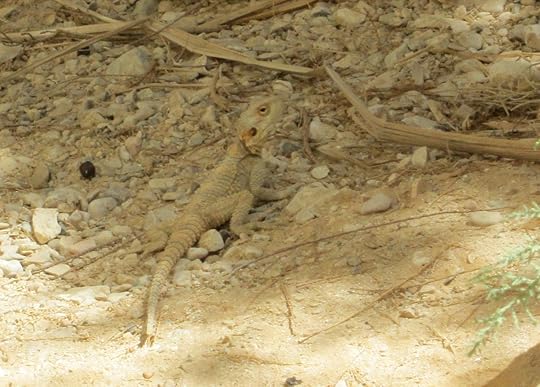 A lizard near En Avodot SpringsWhen we enter the valley for our hike we will see a topographic map. We will be taken by the chalk, white eocene limestone and thin seams of brown-black flint. We will walk along Avadot stream which is fed by En Mor, En Avadot and En Ma’arif springs.
A lizard near En Avodot SpringsWhen we enter the valley for our hike we will see a topographic map. We will be taken by the chalk, white eocene limestone and thin seams of brown-black flint. We will walk along Avadot stream which is fed by En Mor, En Avadot and En Ma’arif springs.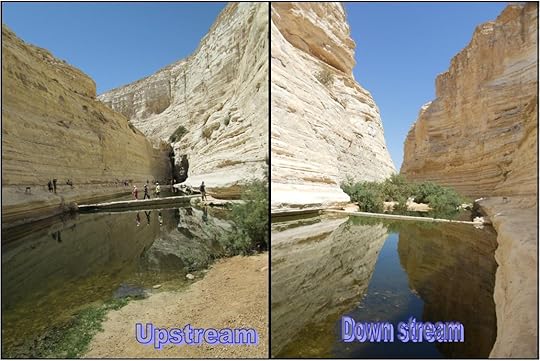 Looking upstream to the water fall and down stream at dam along Wadi AvodatWe will cross an agricultural earthen dam designed to contain water for irrigation purposes. At the end of the valley there is a waterfall where we will stop to take in the beauty. Then we will continue up a stairway hewn in stone and follow the creek on the upper level.
Looking upstream to the water fall and down stream at dam along Wadi AvodatWe will cross an agricultural earthen dam designed to contain water for irrigation purposes. At the end of the valley there is a waterfall where we will stop to take in the beauty. Then we will continue up a stairway hewn in stone and follow the creek on the upper level. Getting ready to rest beneath the tamarask trees along Ein AvodatWe will admire the salt grass, reeds, bulrushes and nitraria retusa with its white flowers, red fruit and edible leaves with a salt taste. As we ascend the slopes to the top we will rest under tamarisk or salt cedar trees in order to see the route of our ascent.
Getting ready to rest beneath the tamarask trees along Ein AvodatWe will admire the salt grass, reeds, bulrushes and nitraria retusa with its white flowers, red fruit and edible leaves with a salt taste. As we ascend the slopes to the top we will rest under tamarisk or salt cedar trees in order to see the route of our ascent.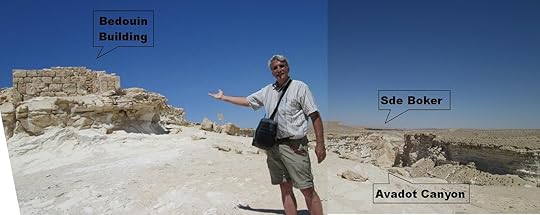 Ruins at the top of En AvedatWe will come upon old buildings used by Bedouins who drew water from En Ma’arif springs when the village of Avedat ceased to be inhabited. Our bus will be waiting to pick us up as we continue our trip into the Judean desert.
Ruins at the top of En AvedatWe will come upon old buildings used by Bedouins who drew water from En Ma’arif springs when the village of Avedat ceased to be inhabited. Our bus will be waiting to pick us up as we continue our trip into the Judean desert. 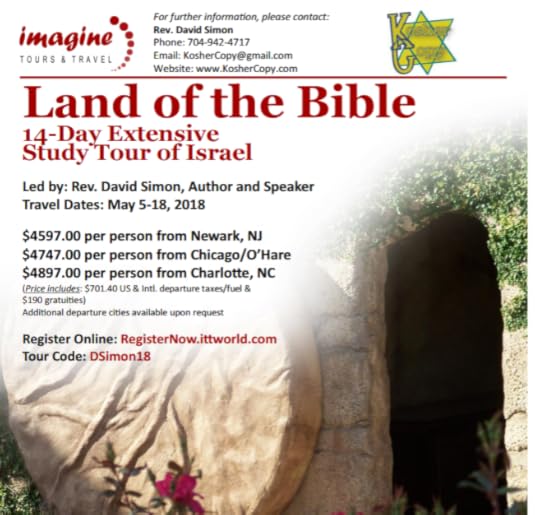 Join us on a trip to the Holy Land by clicking the link below
Join us on a trip to the Holy Land by clicking the link below
Please join us on our 14 day trip to the Holy Land in May 2018. More information can be found at http://www.koshercopy.com/tour-of-israel/ . Links on this page lead to our itinerary and a page where you can sign up to join us on our journey. Our 14 day trip to the Holy Land in May 2018 will be an unforgettable experience, well worth the time and cost which is published.
 Views from a hike through the lower Wadi AvedatThe Bible tells us the spies, “went up and explored the land from the Desert of Zin as far as Rehob, toward Lebo Hamath. They went up through the Negev and came to Hebron … When they reached the Valley of Eshkol, they cut off a branch bearing a single cluster of grapes. Two of them carried it on a pole between them, along with some pomegranates and figs.” (Nu 13) Ein Avedat is on a major road which leads from the south to the Judean hill country.
Views from a hike through the lower Wadi AvedatThe Bible tells us the spies, “went up and explored the land from the Desert of Zin as far as Rehob, toward Lebo Hamath. They went up through the Negev and came to Hebron … When they reached the Valley of Eshkol, they cut off a branch bearing a single cluster of grapes. Two of them carried it on a pole between them, along with some pomegranates and figs.” (Nu 13) Ein Avedat is on a major road which leads from the south to the Judean hill country.  There are many modes of transportation in the Negev including Trains and CamelsWe will follow the return route of the twelve spies as we travel from Beer Sheba to Sde Boker and Avadat. The road continues to Eilat on the Red Sea and then to the west (traditional site of Mt. Sinai) and to the east (south to Arabia and Midian). The road runs through the desert. Our stopping point is an oasis where surely the spies stopped to drink some water.
There are many modes of transportation in the Negev including Trains and CamelsWe will follow the return route of the twelve spies as we travel from Beer Sheba to Sde Boker and Avadat. The road continues to Eilat on the Red Sea and then to the west (traditional site of Mt. Sinai) and to the east (south to Arabia and Midian). The road runs through the desert. Our stopping point is an oasis where surely the spies stopped to drink some water. This is a picture and a map of ruins at AvadatThe Nabateans traversed this area in the first centuries BC and AD. They carried various types of merchandise along what is known as the incense route including myrrh and frankincense. Abdah or Obodat was built by the Nabateans and became their second most important city after Petra. Springs in the area allowed agricultural development which included diversion streams and dams. With the demise of the Nabateans other people continued to live and farm the area through the Roman and Byzantine eras. It is said Nabataean King Obodas I (96 to 85 BC) after whom the town is named was buried in the area.
This is a picture and a map of ruins at AvadatThe Nabateans traversed this area in the first centuries BC and AD. They carried various types of merchandise along what is known as the incense route including myrrh and frankincense. Abdah or Obodat was built by the Nabateans and became their second most important city after Petra. Springs in the area allowed agricultural development which included diversion streams and dams. With the demise of the Nabateans other people continued to live and farm the area through the Roman and Byzantine eras. It is said Nabataean King Obodas I (96 to 85 BC) after whom the town is named was buried in the area. This is the view of Wadi Zin from Sde BokerWe will approach Wadi Avadat by way of Sde Boker. The Kibbutz here is famous for carrying out the Zionist dream of making the desert bloom. David Ben Gurion, Israel’s first Prime Minister lived and was buried here in a grave that overlooks the wide valley through which the stream flows. From the gravesite we will look down on Wadi Zin where our hike will begin.
This is the view of Wadi Zin from Sde BokerWe will approach Wadi Avadat by way of Sde Boker. The Kibbutz here is famous for carrying out the Zionist dream of making the desert bloom. David Ben Gurion, Israel’s first Prime Minister lived and was buried here in a grave that overlooks the wide valley through which the stream flows. From the gravesite we will look down on Wadi Zin where our hike will begin. Ibex at Sde Boker with Wadi Zin in the backgroundWe will also see Ibex and other wildlife native to the area. Psalm 104:18 could speak of animals in the area. It says, “The high mountains belong to the wild goats; the crags are a refuge for the hyrax.” We will see lizards, fish and some birds. Swifts, wheatears, partridges, chukars, babblers, desert swallows, rock doves and vultures fly above the valley. Vols and the desert dormouse wander the trail by night.
Ibex at Sde Boker with Wadi Zin in the backgroundWe will also see Ibex and other wildlife native to the area. Psalm 104:18 could speak of animals in the area. It says, “The high mountains belong to the wild goats; the crags are a refuge for the hyrax.” We will see lizards, fish and some birds. Swifts, wheatears, partridges, chukars, babblers, desert swallows, rock doves and vultures fly above the valley. Vols and the desert dormouse wander the trail by night. A lizard near En Avodot SpringsWhen we enter the valley for our hike we will see a topographic map. We will be taken by the chalk, white eocene limestone and thin seams of brown-black flint. We will walk along Avadot stream which is fed by En Mor, En Avadot and En Ma’arif springs.
A lizard near En Avodot SpringsWhen we enter the valley for our hike we will see a topographic map. We will be taken by the chalk, white eocene limestone and thin seams of brown-black flint. We will walk along Avadot stream which is fed by En Mor, En Avadot and En Ma’arif springs. Looking upstream to the water fall and down stream at dam along Wadi AvodatWe will cross an agricultural earthen dam designed to contain water for irrigation purposes. At the end of the valley there is a waterfall where we will stop to take in the beauty. Then we will continue up a stairway hewn in stone and follow the creek on the upper level.
Looking upstream to the water fall and down stream at dam along Wadi AvodatWe will cross an agricultural earthen dam designed to contain water for irrigation purposes. At the end of the valley there is a waterfall where we will stop to take in the beauty. Then we will continue up a stairway hewn in stone and follow the creek on the upper level. Getting ready to rest beneath the tamarask trees along Ein AvodatWe will admire the salt grass, reeds, bulrushes and nitraria retusa with its white flowers, red fruit and edible leaves with a salt taste. As we ascend the slopes to the top we will rest under tamarisk or salt cedar trees in order to see the route of our ascent.
Getting ready to rest beneath the tamarask trees along Ein AvodatWe will admire the salt grass, reeds, bulrushes and nitraria retusa with its white flowers, red fruit and edible leaves with a salt taste. As we ascend the slopes to the top we will rest under tamarisk or salt cedar trees in order to see the route of our ascent. Ruins at the top of En AvedatWe will come upon old buildings used by Bedouins who drew water from En Ma’arif springs when the village of Avedat ceased to be inhabited. Our bus will be waiting to pick us up as we continue our trip into the Judean desert.
Ruins at the top of En AvedatWe will come upon old buildings used by Bedouins who drew water from En Ma’arif springs when the village of Avedat ceased to be inhabited. Our bus will be waiting to pick us up as we continue our trip into the Judean desert.  Join us on a trip to the Holy Land by clicking the link below
Join us on a trip to the Holy Land by clicking the link belowPlease join us on our 14 day trip to the Holy Land in May 2018. More information can be found at http://www.koshercopy.com/tour-of-israel/ . Links on this page lead to our itinerary and a page where you can sign up to join us on our journey. Our 14 day trip to the Holy Land in May 2018 will be an unforgettable experience, well worth the time and cost which is published.
Published on April 21, 2017 03:54
April 18, 2017
Sde Boker
The desert blooms in Sde Boker, a kibbutz in the Northern Negev Mountains which was launched in 1952. A portion of the dream was to show that Israel, any part of the Holy Land could prosper. Many Zionists had the dream of making Israel, all of the land including the desert, bloom. Sde Boker is a prime example of what can be accomplished with proper care and technology in the desert. David Ben Gurion said, “It is in the Negev that the creativity and pioneer vigor of Israel shall be tested.”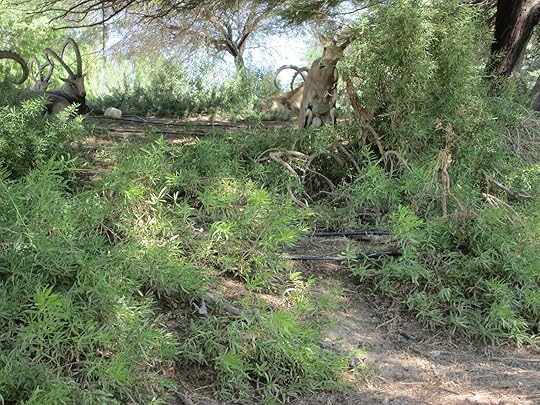 On a 14 day trip to the Holy Land in May 2018 we will visit Sde Boker to see this green oasis with our own eyes, to visit the grave of David Ben Gurion and to walk through the Desert of Zin. We will experience the contrasting landscape as we go from desert sand to the green vegetation of this kibbutz. We will walk through the trees and see the ibex which live in this oasis.
On a 14 day trip to the Holy Land in May 2018 we will visit Sde Boker to see this green oasis with our own eyes, to visit the grave of David Ben Gurion and to walk through the Desert of Zin. We will experience the contrasting landscape as we go from desert sand to the green vegetation of this kibbutz. We will walk through the trees and see the ibex which live in this oasis.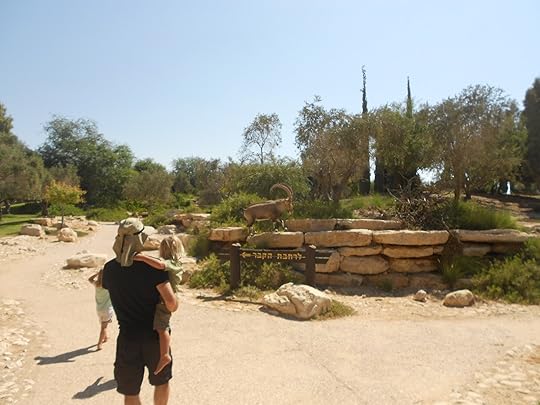 The word Negev, נֶגֶב, means parched. More than half of the land area of Israel is contained in the Negev. The area is desert and receives less than twelve inches of rain per year. The soil ranges from rocky to sandy and is interrupted by dry river beds (wadis) which blossom during the occasional rains. There are vast canyons in several areas and in one place a crater called Makhtesh Ramon.
The word Negev, נֶגֶב, means parched. More than half of the land area of Israel is contained in the Negev. The area is desert and receives less than twelve inches of rain per year. The soil ranges from rocky to sandy and is interrupted by dry river beds (wadis) which blossom during the occasional rains. There are vast canyons in several areas and in one place a crater called Makhtesh Ramon.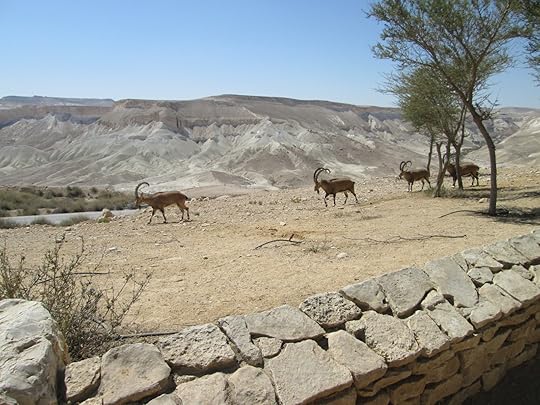 David Ben Gurion along with his wife Paula loved this part of the desert. Ben Gurion retired early, and built his retirement home at Sde Boker. There is a library on the kibbutz which contained his personal books and housing used for the soldiers who protected the former Prime Minister. Today some of these buildings have been turned into a museum.
David Ben Gurion along with his wife Paula loved this part of the desert. Ben Gurion retired early, and built his retirement home at Sde Boker. There is a library on the kibbutz which contained his personal books and housing used for the soldiers who protected the former Prime Minister. Today some of these buildings have been turned into a museum.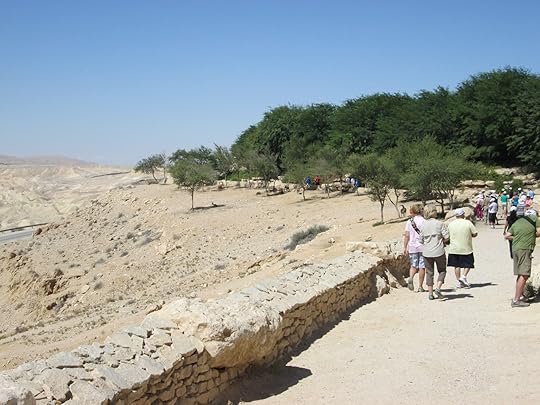 David Ben Gurion once wrote, “The desert provides us with the best opportunity to begin again. This is a vital element of our renaissance in Israel. For it is in mastering nature that man learns to control himself. It is in this sense, more practical than mystic, that I define our Redemption on this land. Israel must continue to cultivate its nationality and to represent the Jewish people without renouncing its glorious past. It must earn this—which is no small task—a right that can only be acquired in the desert.”
David Ben Gurion once wrote, “The desert provides us with the best opportunity to begin again. This is a vital element of our renaissance in Israel. For it is in mastering nature that man learns to control himself. It is in this sense, more practical than mystic, that I define our Redemption on this land. Israel must continue to cultivate its nationality and to represent the Jewish people without renouncing its glorious past. It must earn this—which is no small task—a right that can only be acquired in the desert.”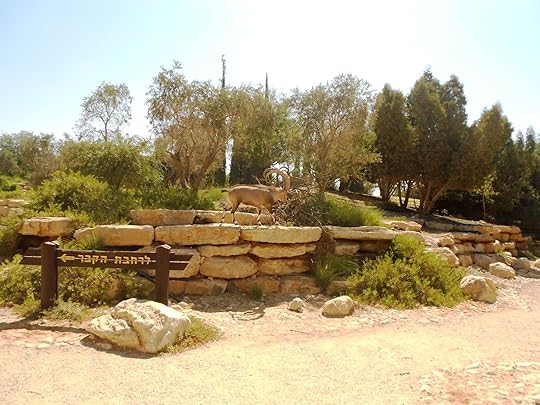 He lived at Kibbutz Sde Boker for twenty years. He and his wife are buried at a beautiful location near the Kibbutz. The gravesite is located on a high plateau with a view to a broad canyon below. The canyon below is known as the Desert of Zin where Israel camped during their years in the wilderness. We will walk through this beautiful area after visiting Sde Boker.
He lived at Kibbutz Sde Boker for twenty years. He and his wife are buried at a beautiful location near the Kibbutz. The gravesite is located on a high plateau with a view to a broad canyon below. The canyon below is known as the Desert of Zin where Israel camped during their years in the wilderness. We will walk through this beautiful area after visiting Sde Boker.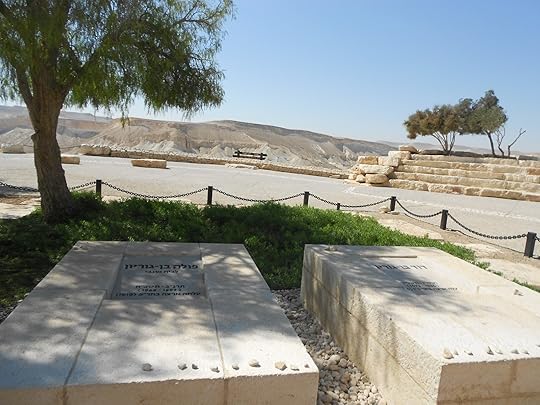 The desert is filled with wide open spaces. Its treelessness enhances a wide sky. The vastness and coloration of the sand enhances sunsets over this seemingly empty sphere. The sun shines bright in the day and the stars and the moon are brilliant at night. David Ben Gurion spoke often about the beautiful solitude of the desert. He said, “Wisdom goes with South. It is written: ‘Whoever seeks wisdom, south shall he go.’”
The desert is filled with wide open spaces. Its treelessness enhances a wide sky. The vastness and coloration of the sand enhances sunsets over this seemingly empty sphere. The sun shines bright in the day and the stars and the moon are brilliant at night. David Ben Gurion spoke often about the beautiful solitude of the desert. He said, “Wisdom goes with South. It is written: ‘Whoever seeks wisdom, south shall he go.’”
 On a 14 day trip to the Holy Land in May 2018 we will visit Sde Boker to see this green oasis with our own eyes, to visit the grave of David Ben Gurion and to walk through the Desert of Zin. We will experience the contrasting landscape as we go from desert sand to the green vegetation of this kibbutz. We will walk through the trees and see the ibex which live in this oasis.
On a 14 day trip to the Holy Land in May 2018 we will visit Sde Boker to see this green oasis with our own eyes, to visit the grave of David Ben Gurion and to walk through the Desert of Zin. We will experience the contrasting landscape as we go from desert sand to the green vegetation of this kibbutz. We will walk through the trees and see the ibex which live in this oasis. The word Negev, נֶגֶב, means parched. More than half of the land area of Israel is contained in the Negev. The area is desert and receives less than twelve inches of rain per year. The soil ranges from rocky to sandy and is interrupted by dry river beds (wadis) which blossom during the occasional rains. There are vast canyons in several areas and in one place a crater called Makhtesh Ramon.
The word Negev, נֶגֶב, means parched. More than half of the land area of Israel is contained in the Negev. The area is desert and receives less than twelve inches of rain per year. The soil ranges from rocky to sandy and is interrupted by dry river beds (wadis) which blossom during the occasional rains. There are vast canyons in several areas and in one place a crater called Makhtesh Ramon. David Ben Gurion along with his wife Paula loved this part of the desert. Ben Gurion retired early, and built his retirement home at Sde Boker. There is a library on the kibbutz which contained his personal books and housing used for the soldiers who protected the former Prime Minister. Today some of these buildings have been turned into a museum.
David Ben Gurion along with his wife Paula loved this part of the desert. Ben Gurion retired early, and built his retirement home at Sde Boker. There is a library on the kibbutz which contained his personal books and housing used for the soldiers who protected the former Prime Minister. Today some of these buildings have been turned into a museum. David Ben Gurion once wrote, “The desert provides us with the best opportunity to begin again. This is a vital element of our renaissance in Israel. For it is in mastering nature that man learns to control himself. It is in this sense, more practical than mystic, that I define our Redemption on this land. Israel must continue to cultivate its nationality and to represent the Jewish people without renouncing its glorious past. It must earn this—which is no small task—a right that can only be acquired in the desert.”
David Ben Gurion once wrote, “The desert provides us with the best opportunity to begin again. This is a vital element of our renaissance in Israel. For it is in mastering nature that man learns to control himself. It is in this sense, more practical than mystic, that I define our Redemption on this land. Israel must continue to cultivate its nationality and to represent the Jewish people without renouncing its glorious past. It must earn this—which is no small task—a right that can only be acquired in the desert.” He lived at Kibbutz Sde Boker for twenty years. He and his wife are buried at a beautiful location near the Kibbutz. The gravesite is located on a high plateau with a view to a broad canyon below. The canyon below is known as the Desert of Zin where Israel camped during their years in the wilderness. We will walk through this beautiful area after visiting Sde Boker.
He lived at Kibbutz Sde Boker for twenty years. He and his wife are buried at a beautiful location near the Kibbutz. The gravesite is located on a high plateau with a view to a broad canyon below. The canyon below is known as the Desert of Zin where Israel camped during their years in the wilderness. We will walk through this beautiful area after visiting Sde Boker. The desert is filled with wide open spaces. Its treelessness enhances a wide sky. The vastness and coloration of the sand enhances sunsets over this seemingly empty sphere. The sun shines bright in the day and the stars and the moon are brilliant at night. David Ben Gurion spoke often about the beautiful solitude of the desert. He said, “Wisdom goes with South. It is written: ‘Whoever seeks wisdom, south shall he go.’”
The desert is filled with wide open spaces. Its treelessness enhances a wide sky. The vastness and coloration of the sand enhances sunsets over this seemingly empty sphere. The sun shines bright in the day and the stars and the moon are brilliant at night. David Ben Gurion spoke often about the beautiful solitude of the desert. He said, “Wisdom goes with South. It is written: ‘Whoever seeks wisdom, south shall he go.’”
Published on April 18, 2017 03:30
April 9, 2017
Be’er-Sheva
Seven wells - this is more the story of our people than most of us would want to admit. We are aliens and strangers in a foreign land. We are a wandering people with no place to call home.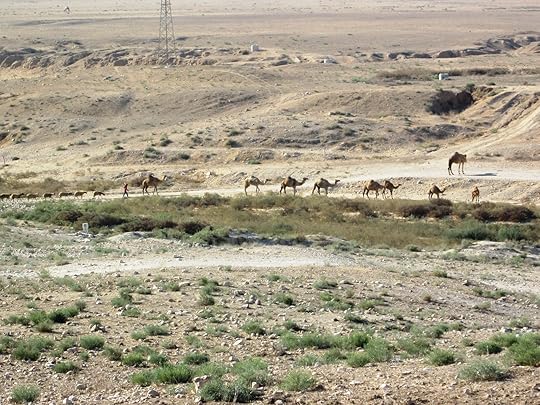 Seven wells - this is not our desire; we want a place to call home. The problem is that for most of history, events have prohibited my people from residing in their homeland. It seems that the story of Abram is hardwired within us and we are predestined as a nation to follow along, seemingly due to a genetic-like code. Descendants of Abraham have moved from Israel to Egypt, and back to Israel (Passover begins in two days). They then moved from Israel to Babylon and Persia. During the Second Temple period some people returned to Israel, while others continued the expansion of their influence to India (and beyond), and through Asia Minor and Macedonia to Rome. From 70 AD until 1948 the descendants of Abraham could not lay claim to their land, and even today most are in diaspora.
Seven wells - this is not our desire; we want a place to call home. The problem is that for most of history, events have prohibited my people from residing in their homeland. It seems that the story of Abram is hardwired within us and we are predestined as a nation to follow along, seemingly due to a genetic-like code. Descendants of Abraham have moved from Israel to Egypt, and back to Israel (Passover begins in two days). They then moved from Israel to Babylon and Persia. During the Second Temple period some people returned to Israel, while others continued the expansion of their influence to India (and beyond), and through Asia Minor and Macedonia to Rome. From 70 AD until 1948 the descendants of Abraham could not lay claim to their land, and even today most are in diaspora.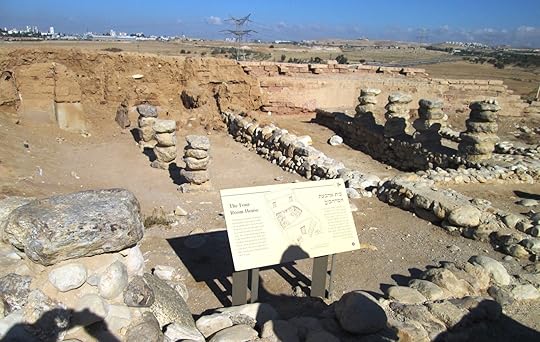 Abram was born almost 4,000 years ago in the land of Chaldea to the south of Babel. One tradition states that his father, Terah, was a government official. The king (Nimrod) had a dream that Terah’s child would become great, so out of jealousy the family of Nahor was banished from the land.
Abram was born almost 4,000 years ago in the land of Chaldea to the south of Babel. One tradition states that his father, Terah, was a government official. The king (Nimrod) had a dream that Terah’s child would become great, so out of jealousy the family of Nahor was banished from the land.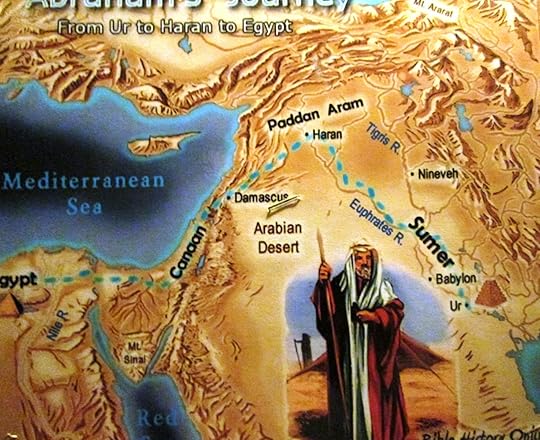 Terah moved his family up the Euphrates River to Haran, an ancient city which capitalized on its location along major trade routes. Abram spent his years as a young and middle-aged adult in this city. It is said that he met Noah and became a believer in the One God Most High through the stories of Noah.
Terah moved his family up the Euphrates River to Haran, an ancient city which capitalized on its location along major trade routes. Abram spent his years as a young and middle-aged adult in this city. It is said that he met Noah and became a believer in the One God Most High through the stories of Noah.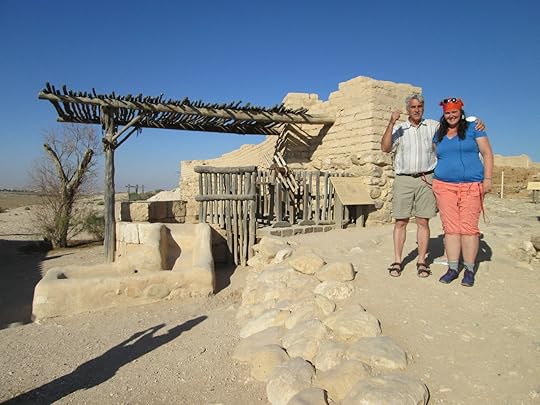 When Abram was seventy-five years old, God told him to “Go from your country, your people and your father’s household to the land I will show you.” In obedience to God’s words, Abram became a nomad. He journeyed first to Shechem, then to Bethel, and then to the Negev Desert where the ancient and modern cities of Be’er-Sheva are located. Abram, who was re-named Abraham, continued as a nomad without a land of his own for his whole life, living in Egypt for a time and finally being buried in Hebron.
When Abram was seventy-five years old, God told him to “Go from your country, your people and your father’s household to the land I will show you.” In obedience to God’s words, Abram became a nomad. He journeyed first to Shechem, then to Bethel, and then to the Negev Desert where the ancient and modern cities of Be’er-Sheva are located. Abram, who was re-named Abraham, continued as a nomad without a land of his own for his whole life, living in Egypt for a time and finally being buried in Hebron.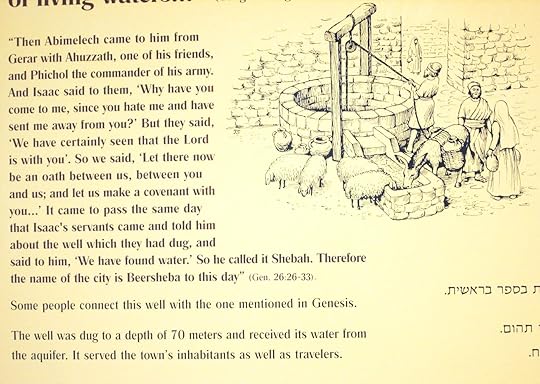 Be’er-Sheva translated literally means “seven wells.” The name of the city bears witness to the nomadic nature of the Patriarchal families of Israel. Both Abraham and his son Isaac dug and claimed wells in this area (water is a valuable resource in the desert). However, these wells were contested. The Bible records treaties made (oath is another meaning of the word sheva) and broken between the fathers of Israel and King Abimelech (translated literally “father king”) of Gerar.
Be’er-Sheva translated literally means “seven wells.” The name of the city bears witness to the nomadic nature of the Patriarchal families of Israel. Both Abraham and his son Isaac dug and claimed wells in this area (water is a valuable resource in the desert). However, these wells were contested. The Bible records treaties made (oath is another meaning of the word sheva) and broken between the fathers of Israel and King Abimelech (translated literally “father king”) of Gerar.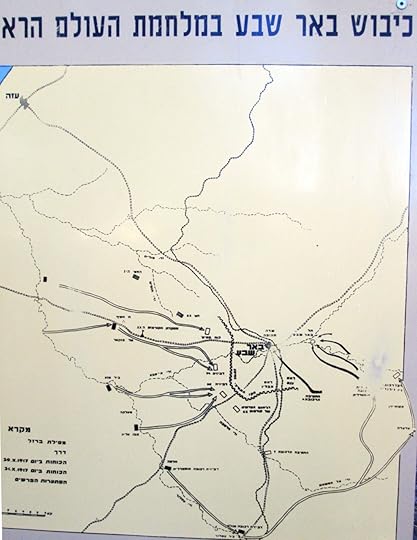 Settlement at Be’er-Sheva dates back to the Iron Age (4,000 BC), and by the time of Abraham the city was a trade center on the Central Ridge Highway, which led south from Israel to the land of Egypt. The city was built in the early Canaanite circular pattern with high visibility from watchtowers and a shape which enabled archers to aim their weapons in any direction.
Settlement at Be’er-Sheva dates back to the Iron Age (4,000 BC), and by the time of Abraham the city was a trade center on the Central Ridge Highway, which led south from Israel to the land of Egypt. The city was built in the early Canaanite circular pattern with high visibility from watchtowers and a shape which enabled archers to aim their weapons in any direction.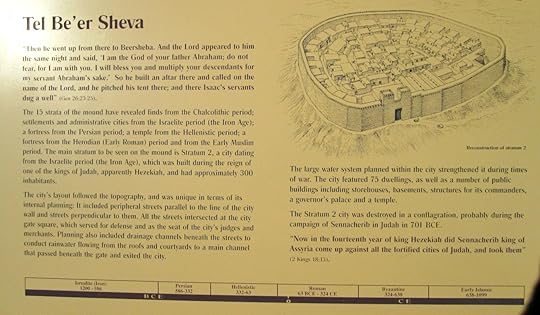
On a 14 day trip to the Holy Land in May 2018, we will be sightseeing by bus and on foot, and seeing the places where the people of the Bible lived. On May 8th we will visit and spend the night in Be’er-Sheva, a city where Abraham, Isaac, and Jacob lived. An itinerary of our journey can be found online. If you would like to join us on the trip of a lifetime, please sign up by using this link.
 Seven wells - this is not our desire; we want a place to call home. The problem is that for most of history, events have prohibited my people from residing in their homeland. It seems that the story of Abram is hardwired within us and we are predestined as a nation to follow along, seemingly due to a genetic-like code. Descendants of Abraham have moved from Israel to Egypt, and back to Israel (Passover begins in two days). They then moved from Israel to Babylon and Persia. During the Second Temple period some people returned to Israel, while others continued the expansion of their influence to India (and beyond), and through Asia Minor and Macedonia to Rome. From 70 AD until 1948 the descendants of Abraham could not lay claim to their land, and even today most are in diaspora.
Seven wells - this is not our desire; we want a place to call home. The problem is that for most of history, events have prohibited my people from residing in their homeland. It seems that the story of Abram is hardwired within us and we are predestined as a nation to follow along, seemingly due to a genetic-like code. Descendants of Abraham have moved from Israel to Egypt, and back to Israel (Passover begins in two days). They then moved from Israel to Babylon and Persia. During the Second Temple period some people returned to Israel, while others continued the expansion of their influence to India (and beyond), and through Asia Minor and Macedonia to Rome. From 70 AD until 1948 the descendants of Abraham could not lay claim to their land, and even today most are in diaspora. Abram was born almost 4,000 years ago in the land of Chaldea to the south of Babel. One tradition states that his father, Terah, was a government official. The king (Nimrod) had a dream that Terah’s child would become great, so out of jealousy the family of Nahor was banished from the land.
Abram was born almost 4,000 years ago in the land of Chaldea to the south of Babel. One tradition states that his father, Terah, was a government official. The king (Nimrod) had a dream that Terah’s child would become great, so out of jealousy the family of Nahor was banished from the land. Terah moved his family up the Euphrates River to Haran, an ancient city which capitalized on its location along major trade routes. Abram spent his years as a young and middle-aged adult in this city. It is said that he met Noah and became a believer in the One God Most High through the stories of Noah.
Terah moved his family up the Euphrates River to Haran, an ancient city which capitalized on its location along major trade routes. Abram spent his years as a young and middle-aged adult in this city. It is said that he met Noah and became a believer in the One God Most High through the stories of Noah. When Abram was seventy-five years old, God told him to “Go from your country, your people and your father’s household to the land I will show you.” In obedience to God’s words, Abram became a nomad. He journeyed first to Shechem, then to Bethel, and then to the Negev Desert where the ancient and modern cities of Be’er-Sheva are located. Abram, who was re-named Abraham, continued as a nomad without a land of his own for his whole life, living in Egypt for a time and finally being buried in Hebron.
When Abram was seventy-five years old, God told him to “Go from your country, your people and your father’s household to the land I will show you.” In obedience to God’s words, Abram became a nomad. He journeyed first to Shechem, then to Bethel, and then to the Negev Desert where the ancient and modern cities of Be’er-Sheva are located. Abram, who was re-named Abraham, continued as a nomad without a land of his own for his whole life, living in Egypt for a time and finally being buried in Hebron. Be’er-Sheva translated literally means “seven wells.” The name of the city bears witness to the nomadic nature of the Patriarchal families of Israel. Both Abraham and his son Isaac dug and claimed wells in this area (water is a valuable resource in the desert). However, these wells were contested. The Bible records treaties made (oath is another meaning of the word sheva) and broken between the fathers of Israel and King Abimelech (translated literally “father king”) of Gerar.
Be’er-Sheva translated literally means “seven wells.” The name of the city bears witness to the nomadic nature of the Patriarchal families of Israel. Both Abraham and his son Isaac dug and claimed wells in this area (water is a valuable resource in the desert). However, these wells were contested. The Bible records treaties made (oath is another meaning of the word sheva) and broken between the fathers of Israel and King Abimelech (translated literally “father king”) of Gerar. Settlement at Be’er-Sheva dates back to the Iron Age (4,000 BC), and by the time of Abraham the city was a trade center on the Central Ridge Highway, which led south from Israel to the land of Egypt. The city was built in the early Canaanite circular pattern with high visibility from watchtowers and a shape which enabled archers to aim their weapons in any direction.
Settlement at Be’er-Sheva dates back to the Iron Age (4,000 BC), and by the time of Abraham the city was a trade center on the Central Ridge Highway, which led south from Israel to the land of Egypt. The city was built in the early Canaanite circular pattern with high visibility from watchtowers and a shape which enabled archers to aim their weapons in any direction.
On a 14 day trip to the Holy Land in May 2018, we will be sightseeing by bus and on foot, and seeing the places where the people of the Bible lived. On May 8th we will visit and spend the night in Be’er-Sheva, a city where Abraham, Isaac, and Jacob lived. An itinerary of our journey can be found online. If you would like to join us on the trip of a lifetime, please sign up by using this link.
Published on April 09, 2017 03:30
April 2, 2017
Jesse’s Sons: Part 3
Eliab was back in the valley he had grown to love, but this time it was not to herd sheep, it was for war. And the conflict was not going well, for an evil spirit tormented King Saul and apparently his people had fallen out of favor with God. The Philistines were successfully expanding their kingdom into Benjamin and were on their way to raid and loot the Judean highlands. King Saul and his generals decided to stand against them in the Elah Valley. This is a place where they had been successful before. In the days of Joshua God helped His people to win a decisive victory over the Amorites by sending a hail storm (Joshua 10:10-11). Samson, the Judge of Israel had killed Philistines in the area with the jawbone of an ass.When King Saul called out his army Eliab with two of his brothers, Abinadab and Shammah responded. They were camped below the town of Azekah, an ancient village set at a strategic vantage point where the Elah Valley wraps around a hill. From the top of the hill the entire valley could be observed from end to end. The high position also enabled communication with fire signals which could be seen in the south at Lachish to the east in Judah and to the north in Benjamin. The Assyrians at a later date said the the place was like the nest of an eagle located on a mountain ridge. Simon bar Kocba set a fort in this area in the early second century and his trademark tunnels still run just below the surface. This defendable position was easily accessible for King Saul from his capital at Gibeah through Beit Shemesh.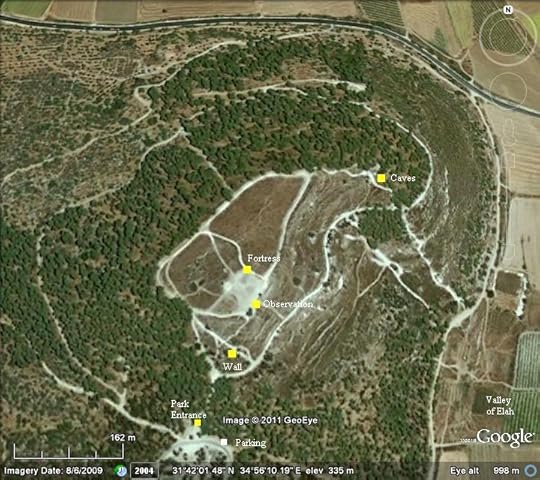 Satellite View of AzekahThe army of the Philistines was camped on the south side of the valley near the village of Socoh. The Elah River stood between the two armies and was nicknamed in anticipation of the battle to come “Ephes Dammim” or the boundary of blood.
Satellite View of AzekahThe army of the Philistines was camped on the south side of the valley near the village of Socoh. The Elah River stood between the two armies and was nicknamed in anticipation of the battle to come “Ephes Dammim” or the boundary of blood. Socoh HillBut the battle did not come as anticipated, for the Philistines from Gath had a powerful diversion with them, and after a time of acting out and noise making by both armies in order to bring fear to the opposition the Philistines revealed a secret weapon. His name was Goliath, which means splendor. And he was magnificent. He stood nine feet tall and carried a spear like a weaver's beam. He issued a challenge which according to the rules of war in that day must be accepted, “Choose one man and let him fight me. If he is able to kill me, then the Philistines will become your servants: but if I prevail against him, and kill him, then you shall be our servants.”
Socoh HillBut the battle did not come as anticipated, for the Philistines from Gath had a powerful diversion with them, and after a time of acting out and noise making by both armies in order to bring fear to the opposition the Philistines revealed a secret weapon. His name was Goliath, which means splendor. And he was magnificent. He stood nine feet tall and carried a spear like a weaver's beam. He issued a challenge which according to the rules of war in that day must be accepted, “Choose one man and let him fight me. If he is able to kill me, then the Philistines will become your servants: but if I prevail against him, and kill him, then you shall be our servants.”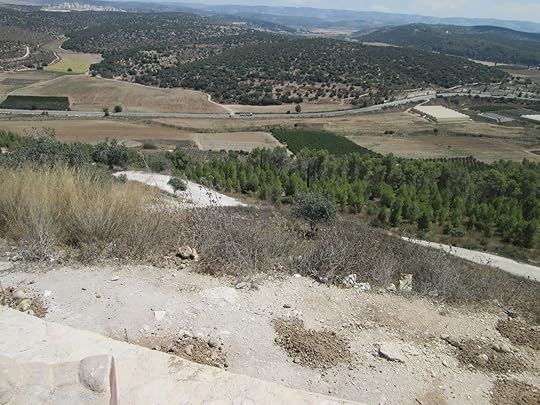 View from the top of AzekahThe army of Israel trembled, for no one was willing to fight Goliath. He was tall, he sounded mean, he wore a coat of iron and carried a large spear with a sharp tip. By arm length alone a Hebrew was bound to lose, and Israel did not yet possess either iron armor or iron tipped spears.King Saul called for volunteers, but no one stepped forward. He promised riches to the man who won, but no one was willing. The King even said he would give his daughter as a wife to the successful soldier, but they would not be enticed. The challenge was made each morning and evening for forty days with taunting and ridicule, and every man of the Hebrew army feared for his life.
View from the top of AzekahThe army of Israel trembled, for no one was willing to fight Goliath. He was tall, he sounded mean, he wore a coat of iron and carried a large spear with a sharp tip. By arm length alone a Hebrew was bound to lose, and Israel did not yet possess either iron armor or iron tipped spears.King Saul called for volunteers, but no one stepped forward. He promised riches to the man who won, but no one was willing. The King even said he would give his daughter as a wife to the successful soldier, but they would not be enticed. The challenge was made each morning and evening for forty days with taunting and ridicule, and every man of the Hebrew army feared for his life. View from the top of AzekahEliab’s elderly father Jesse grew concerned, for he was in Bethlehem and had not seen or heard from his oldest three sons for more than a month. He decided to send provisions by way of his youngest son David because he served the king and knew where the army was camped. David found a substitute to take his place with the sheep, and rushed to the camp of the Hebrews.As David arrived the Hebrews were gathering to hear Goliath make one of his evening rants. The Lord filled David with grief because no one trusted God enough to step forward. David told his brothers that he would go to the king and volunteer for the battle. Anger flashed in Eliab’s heart, and he told David he was as spoiled as Jacob’s son Joseph who pulled stunts like this to embarrass his brothers.But discouragement from his brothers did not stop David from going to King Saul. He said, “Let no one lose heart on account of this Philistine; your servant will go and fight him.”
View from the top of AzekahEliab’s elderly father Jesse grew concerned, for he was in Bethlehem and had not seen or heard from his oldest three sons for more than a month. He decided to send provisions by way of his youngest son David because he served the king and knew where the army was camped. David found a substitute to take his place with the sheep, and rushed to the camp of the Hebrews.As David arrived the Hebrews were gathering to hear Goliath make one of his evening rants. The Lord filled David with grief because no one trusted God enough to step forward. David told his brothers that he would go to the king and volunteer for the battle. Anger flashed in Eliab’s heart, and he told David he was as spoiled as Jacob’s son Joseph who pulled stunts like this to embarrass his brothers.But discouragement from his brothers did not stop David from going to King Saul. He said, “Let no one lose heart on account of this Philistine; your servant will go and fight him.”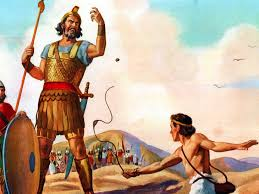 David fighting GoliathSaul was concerned because of David’s small size and his lack of experience, but David said to the King, “Your servant has been keeping his father’s sheep. When a lion or a bear came and carried off a sheep from the flock, I went after it, struck it and rescued the sheep from its mouth. When it turned on me, I seized it by its hair, struck it and killed it. Your servant has killed both the lion and the bear; this uncircumcised Philistine will be like one of them, because he has defied the armies of the living God. The Lord who rescued me from the paw of the lion and the paw of the bear will rescue me from the hand of this Philistine.” Saul knew there were no other options, and that time was short before the Philistine’s patience would run out. He agreed that the young shepherd could accept the challenge. The rest is history. Antigonus of Socoh, a voice from the Mishnah who lived 700 years after this event said, perhaps remembering this story, "Be not like servants who serve the master on condition that they receive a reward. Rather be like servants who serve the master irrespective of any reward. And let the fear of heaven be upon you."
David fighting GoliathSaul was concerned because of David’s small size and his lack of experience, but David said to the King, “Your servant has been keeping his father’s sheep. When a lion or a bear came and carried off a sheep from the flock, I went after it, struck it and rescued the sheep from its mouth. When it turned on me, I seized it by its hair, struck it and killed it. Your servant has killed both the lion and the bear; this uncircumcised Philistine will be like one of them, because he has defied the armies of the living God. The Lord who rescued me from the paw of the lion and the paw of the bear will rescue me from the hand of this Philistine.” Saul knew there were no other options, and that time was short before the Philistine’s patience would run out. He agreed that the young shepherd could accept the challenge. The rest is history. Antigonus of Socoh, a voice from the Mishnah who lived 700 years after this event said, perhaps remembering this story, "Be not like servants who serve the master on condition that they receive a reward. Rather be like servants who serve the master irrespective of any reward. And let the fear of heaven be upon you." Sign at the entrance to Azekah siteThe Elah Valley is quiet now. Azekah and Socoh are now part of British Park, a Jewish National Fund nature sanctuary. Blue Turmus (Lupin) flowers sprout around Socoh rather than Philistines. Farmers raise crops in the valleys and tourists visit historic sites without fear of being taunted by the giant.
Sign at the entrance to Azekah siteThe Elah Valley is quiet now. Azekah and Socoh are now part of British Park, a Jewish National Fund nature sanctuary. Blue Turmus (Lupin) flowers sprout around Socoh rather than Philistines. Farmers raise crops in the valleys and tourists visit historic sites without fear of being taunted by the giant.
 Satellite View of AzekahThe army of the Philistines was camped on the south side of the valley near the village of Socoh. The Elah River stood between the two armies and was nicknamed in anticipation of the battle to come “Ephes Dammim” or the boundary of blood.
Satellite View of AzekahThe army of the Philistines was camped on the south side of the valley near the village of Socoh. The Elah River stood between the two armies and was nicknamed in anticipation of the battle to come “Ephes Dammim” or the boundary of blood. Socoh HillBut the battle did not come as anticipated, for the Philistines from Gath had a powerful diversion with them, and after a time of acting out and noise making by both armies in order to bring fear to the opposition the Philistines revealed a secret weapon. His name was Goliath, which means splendor. And he was magnificent. He stood nine feet tall and carried a spear like a weaver's beam. He issued a challenge which according to the rules of war in that day must be accepted, “Choose one man and let him fight me. If he is able to kill me, then the Philistines will become your servants: but if I prevail against him, and kill him, then you shall be our servants.”
Socoh HillBut the battle did not come as anticipated, for the Philistines from Gath had a powerful diversion with them, and after a time of acting out and noise making by both armies in order to bring fear to the opposition the Philistines revealed a secret weapon. His name was Goliath, which means splendor. And he was magnificent. He stood nine feet tall and carried a spear like a weaver's beam. He issued a challenge which according to the rules of war in that day must be accepted, “Choose one man and let him fight me. If he is able to kill me, then the Philistines will become your servants: but if I prevail against him, and kill him, then you shall be our servants.” View from the top of AzekahThe army of Israel trembled, for no one was willing to fight Goliath. He was tall, he sounded mean, he wore a coat of iron and carried a large spear with a sharp tip. By arm length alone a Hebrew was bound to lose, and Israel did not yet possess either iron armor or iron tipped spears.King Saul called for volunteers, but no one stepped forward. He promised riches to the man who won, but no one was willing. The King even said he would give his daughter as a wife to the successful soldier, but they would not be enticed. The challenge was made each morning and evening for forty days with taunting and ridicule, and every man of the Hebrew army feared for his life.
View from the top of AzekahThe army of Israel trembled, for no one was willing to fight Goliath. He was tall, he sounded mean, he wore a coat of iron and carried a large spear with a sharp tip. By arm length alone a Hebrew was bound to lose, and Israel did not yet possess either iron armor or iron tipped spears.King Saul called for volunteers, but no one stepped forward. He promised riches to the man who won, but no one was willing. The King even said he would give his daughter as a wife to the successful soldier, but they would not be enticed. The challenge was made each morning and evening for forty days with taunting and ridicule, and every man of the Hebrew army feared for his life. View from the top of AzekahEliab’s elderly father Jesse grew concerned, for he was in Bethlehem and had not seen or heard from his oldest three sons for more than a month. He decided to send provisions by way of his youngest son David because he served the king and knew where the army was camped. David found a substitute to take his place with the sheep, and rushed to the camp of the Hebrews.As David arrived the Hebrews were gathering to hear Goliath make one of his evening rants. The Lord filled David with grief because no one trusted God enough to step forward. David told his brothers that he would go to the king and volunteer for the battle. Anger flashed in Eliab’s heart, and he told David he was as spoiled as Jacob’s son Joseph who pulled stunts like this to embarrass his brothers.But discouragement from his brothers did not stop David from going to King Saul. He said, “Let no one lose heart on account of this Philistine; your servant will go and fight him.”
View from the top of AzekahEliab’s elderly father Jesse grew concerned, for he was in Bethlehem and had not seen or heard from his oldest three sons for more than a month. He decided to send provisions by way of his youngest son David because he served the king and knew where the army was camped. David found a substitute to take his place with the sheep, and rushed to the camp of the Hebrews.As David arrived the Hebrews were gathering to hear Goliath make one of his evening rants. The Lord filled David with grief because no one trusted God enough to step forward. David told his brothers that he would go to the king and volunteer for the battle. Anger flashed in Eliab’s heart, and he told David he was as spoiled as Jacob’s son Joseph who pulled stunts like this to embarrass his brothers.But discouragement from his brothers did not stop David from going to King Saul. He said, “Let no one lose heart on account of this Philistine; your servant will go and fight him.” David fighting GoliathSaul was concerned because of David’s small size and his lack of experience, but David said to the King, “Your servant has been keeping his father’s sheep. When a lion or a bear came and carried off a sheep from the flock, I went after it, struck it and rescued the sheep from its mouth. When it turned on me, I seized it by its hair, struck it and killed it. Your servant has killed both the lion and the bear; this uncircumcised Philistine will be like one of them, because he has defied the armies of the living God. The Lord who rescued me from the paw of the lion and the paw of the bear will rescue me from the hand of this Philistine.” Saul knew there were no other options, and that time was short before the Philistine’s patience would run out. He agreed that the young shepherd could accept the challenge. The rest is history. Antigonus of Socoh, a voice from the Mishnah who lived 700 years after this event said, perhaps remembering this story, "Be not like servants who serve the master on condition that they receive a reward. Rather be like servants who serve the master irrespective of any reward. And let the fear of heaven be upon you."
David fighting GoliathSaul was concerned because of David’s small size and his lack of experience, but David said to the King, “Your servant has been keeping his father’s sheep. When a lion or a bear came and carried off a sheep from the flock, I went after it, struck it and rescued the sheep from its mouth. When it turned on me, I seized it by its hair, struck it and killed it. Your servant has killed both the lion and the bear; this uncircumcised Philistine will be like one of them, because he has defied the armies of the living God. The Lord who rescued me from the paw of the lion and the paw of the bear will rescue me from the hand of this Philistine.” Saul knew there were no other options, and that time was short before the Philistine’s patience would run out. He agreed that the young shepherd could accept the challenge. The rest is history. Antigonus of Socoh, a voice from the Mishnah who lived 700 years after this event said, perhaps remembering this story, "Be not like servants who serve the master on condition that they receive a reward. Rather be like servants who serve the master irrespective of any reward. And let the fear of heaven be upon you." Sign at the entrance to Azekah siteThe Elah Valley is quiet now. Azekah and Socoh are now part of British Park, a Jewish National Fund nature sanctuary. Blue Turmus (Lupin) flowers sprout around Socoh rather than Philistines. Farmers raise crops in the valleys and tourists visit historic sites without fear of being taunted by the giant.
Sign at the entrance to Azekah siteThe Elah Valley is quiet now. Azekah and Socoh are now part of British Park, a Jewish National Fund nature sanctuary. Blue Turmus (Lupin) flowers sprout around Socoh rather than Philistines. Farmers raise crops in the valleys and tourists visit historic sites without fear of being taunted by the giant.
Published on April 02, 2017 05:05
April 1, 2017
Jesse’s Sons: Part 2
Eliab and his father Jesse spent the month descending the steep slopes below Bethlehem and then another month guiding their herd through the rich agricultural lands along the Elah river allowing the sheep to graze on the barley stubble. The valley was greener and the trees were taller than around Bethlehem, which he called home. The people of this region were odd, not like his friends in Bethlehem. They spoke with a different accent, ate unclean foods and paid homage to strange gods. 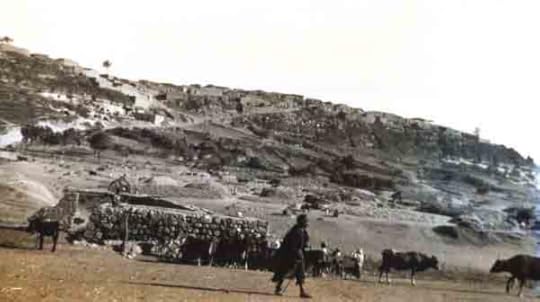 Early picture of the tel at GathAs the shepherds and their sheep rounded the bend past Azekah the Valley began to widen and Eliab was amazed at the large city and the fortress which appeared before him. The hill was at least 300 feet tall with a white coloration, and even from what would normally be a two hour walk (if he and his dad were not slowed by the pace of the sheep) he could see high walls along the ridge upon which the city sat. His father told him this was the powerful city of Gath (Tell es-Safi), a stronghold of the Philistines and the sons of Anak. Jesse saw the look of amazement on his son’s face and stopped him to explain.
Early picture of the tel at GathAs the shepherds and their sheep rounded the bend past Azekah the Valley began to widen and Eliab was amazed at the large city and the fortress which appeared before him. The hill was at least 300 feet tall with a white coloration, and even from what would normally be a two hour walk (if he and his dad were not slowed by the pace of the sheep) he could see high walls along the ridge upon which the city sat. His father told him this was the powerful city of Gath (Tell es-Safi), a stronghold of the Philistines and the sons of Anak. Jesse saw the look of amazement on his son’s face and stopped him to explain.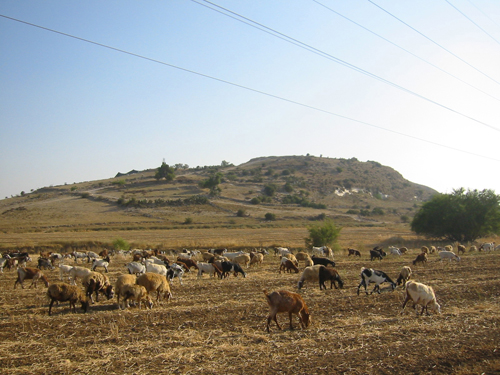 Sheep below Gath - Aren Maeir, Bar-Ilan University“You will find these people different than our people, and they are unlike the Canaanites we have seen in the valley. These are the Sea Peoples, a strong civilization of warriors who feel that they should own the world. The Philistines rule their territory from five strong cities, Ekron is five miles north. Ashdod, Ashkelon and Gaza are to the south and closer to the coast. Gath ruled by King Achish who is the guardian of the Valley of Elah and the coastal plain below his city. He will allow us to graze our sheep in his territory because the people need meat and wool which comes from our animals. But do not trust anyone, and do not go out of your way to talk with them. Answer when spoken to, but keep your conversations short.”
Sheep below Gath - Aren Maeir, Bar-Ilan University“You will find these people different than our people, and they are unlike the Canaanites we have seen in the valley. These are the Sea Peoples, a strong civilization of warriors who feel that they should own the world. The Philistines rule their territory from five strong cities, Ekron is five miles north. Ashdod, Ashkelon and Gaza are to the south and closer to the coast. Gath ruled by King Achish who is the guardian of the Valley of Elah and the coastal plain below his city. He will allow us to graze our sheep in his territory because the people need meat and wool which comes from our animals. But do not trust anyone, and do not go out of your way to talk with them. Answer when spoken to, but keep your conversations short.”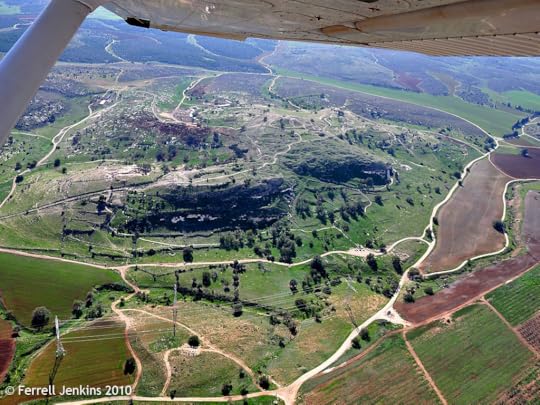 Gath from the air - from Ferrell Travel BlogJesse explained to Eliab, and to his other sons when they first beheld this city, that the people were as strong as their city walls. They had developed a metal called iron, which was far greater in strength than any material which the Hebrews could use. If confronted in a fair face to face, hand to hand, strength to strength battle the Philistines would probably win because their weapons and training were superior to anything Jesse or his people possessed. There were giants in the city, which Jesse had seen. Several were at least eight feet tall, and probably larger. Eliab was to keep his distance from these people, and he was to let his father deal with them as they sold food and cloth.Jesse had been in the city which was very large, loud and cosmopolitan. The gates of Gath were formidable. The ramparts atop the wall were expansive, and the King’s palace was elaborate. The market was several times larger than any village in the Judean highlands and the dwellings were several stories tall. The city was a busy place in which a person could easily get lost, and if not careful a man could get hurt or killed by these warrior people.
Gath from the air - from Ferrell Travel BlogJesse explained to Eliab, and to his other sons when they first beheld this city, that the people were as strong as their city walls. They had developed a metal called iron, which was far greater in strength than any material which the Hebrews could use. If confronted in a fair face to face, hand to hand, strength to strength battle the Philistines would probably win because their weapons and training were superior to anything Jesse or his people possessed. There were giants in the city, which Jesse had seen. Several were at least eight feet tall, and probably larger. Eliab was to keep his distance from these people, and he was to let his father deal with them as they sold food and cloth.Jesse had been in the city which was very large, loud and cosmopolitan. The gates of Gath were formidable. The ramparts atop the wall were expansive, and the King’s palace was elaborate. The market was several times larger than any village in the Judean highlands and the dwellings were several stories tall. The city was a busy place in which a person could easily get lost, and if not careful a man could get hurt or killed by these warrior people.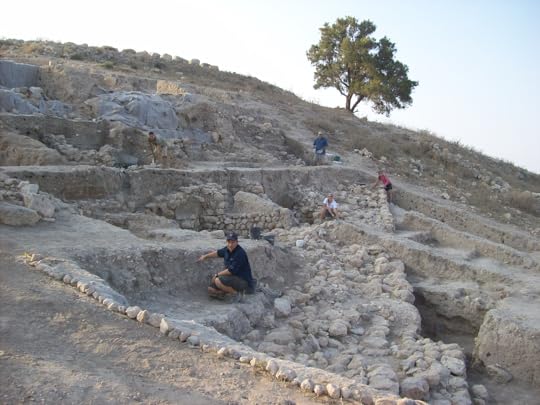 Area F staff and the Early Bronze fortification wall at Tell es-Safi/GathThe people were especially proud of their great temple to dagon, a god of grain. Jesse told the story of how the Hebrew people battled with them during the settlement of the land and how at one time they captured the Ark of the Covenant. He said, “It was only by the strength of our God that we got it back.”Jesse told the story of Samuel who was called a judge by the Hebrew people. “In the end,” he said, “Samson was betrayed by Delilah and taken captive by the Philistines who put his eyes out and made him tread grain like an oxen before their god dagon.”
Area F staff and the Early Bronze fortification wall at Tell es-Safi/GathThe people were especially proud of their great temple to dagon, a god of grain. Jesse told the story of how the Hebrew people battled with them during the settlement of the land and how at one time they captured the Ark of the Covenant. He said, “It was only by the strength of our God that we got it back.”Jesse told the story of Samuel who was called a judge by the Hebrew people. “In the end,” he said, “Samson was betrayed by Delilah and taken captive by the Philistines who put his eyes out and made him tread grain like an oxen before their god dagon.” Temple of dagon with its two pillarsEliab remembered the story and added, “But when the Philistines tried to show the power of their god over our people by chaining Samson to the twin pillars in their temple this strong man was able to shove the supports apart and crush the heathen through the destruction of their temple and their god.
Temple of dagon with its two pillarsEliab remembered the story and added, “But when the Philistines tried to show the power of their god over our people by chaining Samson to the twin pillars in their temple this strong man was able to shove the supports apart and crush the heathen through the destruction of their temple and their god.
 Early picture of the tel at GathAs the shepherds and their sheep rounded the bend past Azekah the Valley began to widen and Eliab was amazed at the large city and the fortress which appeared before him. The hill was at least 300 feet tall with a white coloration, and even from what would normally be a two hour walk (if he and his dad were not slowed by the pace of the sheep) he could see high walls along the ridge upon which the city sat. His father told him this was the powerful city of Gath (Tell es-Safi), a stronghold of the Philistines and the sons of Anak. Jesse saw the look of amazement on his son’s face and stopped him to explain.
Early picture of the tel at GathAs the shepherds and their sheep rounded the bend past Azekah the Valley began to widen and Eliab was amazed at the large city and the fortress which appeared before him. The hill was at least 300 feet tall with a white coloration, and even from what would normally be a two hour walk (if he and his dad were not slowed by the pace of the sheep) he could see high walls along the ridge upon which the city sat. His father told him this was the powerful city of Gath (Tell es-Safi), a stronghold of the Philistines and the sons of Anak. Jesse saw the look of amazement on his son’s face and stopped him to explain. Sheep below Gath - Aren Maeir, Bar-Ilan University“You will find these people different than our people, and they are unlike the Canaanites we have seen in the valley. These are the Sea Peoples, a strong civilization of warriors who feel that they should own the world. The Philistines rule their territory from five strong cities, Ekron is five miles north. Ashdod, Ashkelon and Gaza are to the south and closer to the coast. Gath ruled by King Achish who is the guardian of the Valley of Elah and the coastal plain below his city. He will allow us to graze our sheep in his territory because the people need meat and wool which comes from our animals. But do not trust anyone, and do not go out of your way to talk with them. Answer when spoken to, but keep your conversations short.”
Sheep below Gath - Aren Maeir, Bar-Ilan University“You will find these people different than our people, and they are unlike the Canaanites we have seen in the valley. These are the Sea Peoples, a strong civilization of warriors who feel that they should own the world. The Philistines rule their territory from five strong cities, Ekron is five miles north. Ashdod, Ashkelon and Gaza are to the south and closer to the coast. Gath ruled by King Achish who is the guardian of the Valley of Elah and the coastal plain below his city. He will allow us to graze our sheep in his territory because the people need meat and wool which comes from our animals. But do not trust anyone, and do not go out of your way to talk with them. Answer when spoken to, but keep your conversations short.” Gath from the air - from Ferrell Travel BlogJesse explained to Eliab, and to his other sons when they first beheld this city, that the people were as strong as their city walls. They had developed a metal called iron, which was far greater in strength than any material which the Hebrews could use. If confronted in a fair face to face, hand to hand, strength to strength battle the Philistines would probably win because their weapons and training were superior to anything Jesse or his people possessed. There were giants in the city, which Jesse had seen. Several were at least eight feet tall, and probably larger. Eliab was to keep his distance from these people, and he was to let his father deal with them as they sold food and cloth.Jesse had been in the city which was very large, loud and cosmopolitan. The gates of Gath were formidable. The ramparts atop the wall were expansive, and the King’s palace was elaborate. The market was several times larger than any village in the Judean highlands and the dwellings were several stories tall. The city was a busy place in which a person could easily get lost, and if not careful a man could get hurt or killed by these warrior people.
Gath from the air - from Ferrell Travel BlogJesse explained to Eliab, and to his other sons when they first beheld this city, that the people were as strong as their city walls. They had developed a metal called iron, which was far greater in strength than any material which the Hebrews could use. If confronted in a fair face to face, hand to hand, strength to strength battle the Philistines would probably win because their weapons and training were superior to anything Jesse or his people possessed. There were giants in the city, which Jesse had seen. Several were at least eight feet tall, and probably larger. Eliab was to keep his distance from these people, and he was to let his father deal with them as they sold food and cloth.Jesse had been in the city which was very large, loud and cosmopolitan. The gates of Gath were formidable. The ramparts atop the wall were expansive, and the King’s palace was elaborate. The market was several times larger than any village in the Judean highlands and the dwellings were several stories tall. The city was a busy place in which a person could easily get lost, and if not careful a man could get hurt or killed by these warrior people. Area F staff and the Early Bronze fortification wall at Tell es-Safi/GathThe people were especially proud of their great temple to dagon, a god of grain. Jesse told the story of how the Hebrew people battled with them during the settlement of the land and how at one time they captured the Ark of the Covenant. He said, “It was only by the strength of our God that we got it back.”Jesse told the story of Samuel who was called a judge by the Hebrew people. “In the end,” he said, “Samson was betrayed by Delilah and taken captive by the Philistines who put his eyes out and made him tread grain like an oxen before their god dagon.”
Area F staff and the Early Bronze fortification wall at Tell es-Safi/GathThe people were especially proud of their great temple to dagon, a god of grain. Jesse told the story of how the Hebrew people battled with them during the settlement of the land and how at one time they captured the Ark of the Covenant. He said, “It was only by the strength of our God that we got it back.”Jesse told the story of Samuel who was called a judge by the Hebrew people. “In the end,” he said, “Samson was betrayed by Delilah and taken captive by the Philistines who put his eyes out and made him tread grain like an oxen before their god dagon.” Temple of dagon with its two pillarsEliab remembered the story and added, “But when the Philistines tried to show the power of their god over our people by chaining Samson to the twin pillars in their temple this strong man was able to shove the supports apart and crush the heathen through the destruction of their temple and their god.
Temple of dagon with its two pillarsEliab remembered the story and added, “But when the Philistines tried to show the power of their god over our people by chaining Samson to the twin pillars in their temple this strong man was able to shove the supports apart and crush the heathen through the destruction of their temple and their god.
Published on April 01, 2017 04:51



